- Auschwitz Photos
- Birkenau Photos
- Mauthausen Photos
- Then and Now
- Paintings by Jan Komski – Survivor
- Geoffrey Laurence Paintings
- Paintings by Tamara Deuel – Survivor
- David Aronson Images
- Haunting Memory
- Holocaust Picture Book – The Story of Granny Girl as a Child
- Birkenau and Mauthausen Photos
- Student Art
- Photos – Late 1930s
- Holocaust Photos
- Lest We Forget
- Carapati – a Film
- Warsaw Ghetto Photos
- Nordhausen Liberation
- Dachau Liberation
- Ohrdruf Liberation
- Gunskirchen Lager Pamphlet
- Buchenwald Liberation
- Chuck Ferree
- Lt. Col. Felix Sparks
- Debate the Holocaust?
- Books by Survivors
- Children of Survivors
- Adolf Eichmann – PBS
- Adolf Hitler’s Plan
- Himmler Speech
- Goebbels Diaries
- Letter on Sterilization
- Letters on Euthanasia
- Nazi Letters on Executions
- Page of Glory
- Homosexuals
- Gypsies in Auschwitz I
- Gypsies in Auschwitz 2
- Babi Yar Poem
- Polish Citizens and Jews
- Harold Gordon
- Sidney Iwens
- I Cannot Forget
- Keep Yelling! A Survivor’s Testimony
- A Survivor’s Prayer
- In August of 1942
- Jacque Lipetz
- Walter Frank
- Helen Lazar
- Lucille Eichengreen
- Judith Jagermann
- Filip Muller
- Holocaust Study Guide
- Holocaust Books A-Z
- Anne Frank Biography | 1998 Holocaust Book
- Help Finding People Lost in the Holocaust Search and Unite

Remember.org
- Holocaust history and stories from Holocaust Photos, Survivors, Liberators, Books and Art
- Remember.org Origins
The State Museum Of Auschwitz-Birkenau & Remember.Org Present
- Virtual Tour Home
- Auschwitz I Entrance
- Appleplatz Roll Call Square
- Electrified Fence
- Krankenbrau – Prisoners Hospital
- Block 11 Basement and Cells
- Mala and Edek – Love in Auschwitz
- Father Kolbe Cell
- Krematorium 1
- Birkenau Entrance – Death Gate
- The Unloading Ramp
- Men and Women’s Barracks
- Birkenau Latrines
- The Penal Company – BIb
- Model of Krematorium II
- Krematorium II
- The Rear of Birkenau: The Final Moments
- The Little Wood
- The Ash Pond
- Krematorium V
- Sauna and Kanada
- Sauna Interiors (3)
- Little White House
- Birkenau Woods Incineration Area
- The Judenrampe – Old Ramp
- Russian POWs Graveyard
- 2014 Updated VIrtual Tour
- Auschwitz III – Buna
A Virtual Tour of Auschwitz
by Alan Jacobs and Krysia Jacobs
Start Auschwitz Virtual Tour Start Birkenau Virtual Tour
Overview – Virtual Tour of Auschwitz Updates
The Virtual Tour of Auschwitz explores the concentration camp complex of Auschwitz-Birkenau, the largest killing center in Nazi-occupied Europe. Located in Southern Poland, on the outskirts of the town of Oswiecim, it consisted of the original camp, Auschwitz I , and the much larger second camp of Birkenau (Brzezinka), 2 miles away, plus over 40 sub-camps [ link ], the largest of which was Buna (Monovitz) [ link ].
We’ve updated the original Virtual Tour into videos, which allow a 360-degree view while touring the camp. We’ve added the same videos with captions so you can learn what you are seeing. Be sure to check the updated Tour at the Auschwitz Museum , which grew from this original project as well.
View the Virtual Tour on YouTube
Original Auschwitz Virtual Tour Captions – Auschwitz Virtual Tour
Virtual Tour of Birkenau - Auschwitz II
Birkenau russian graveyard for pow’s, birkenau judenrampe – the first unloading ramp, birkenau woods incineration, birkenau sauna interior, birkenau sauna and kanada, birkenau krematorium v, birkenau ash pond, birkenau little wood, birkenau camp end, birkenau krematorium ii, birkenau krematorium ii model, birkenau penal company.
The camp was established in 1940, less than a year after Germany occupied Poland in WWII, and grew over the next few years into an entire complex providing slave labor for the German industrial facilities in the area. In 1942, it became the largest death camp, carrying out Hitler’s “final solution” – the plan to systematically kill all Jews in Europe.
It is estimated that between 1.1 and 1.5 million people died here. At its peak, Auschwitz I held as many as 20,000 prisoners at a time, Birkenau 90,000 and Buna 10,000.
Historians estimate that among the people sent to Auschwitz there were at least 1,100,000 Jews from all the countries of occupied Europe, over 140,000 Poles (mostly political prisoners), approximately 20,000 Gypsies from several European countries, over 10,000 Soviet prisoners of war, and over ten thousand prisoners of other nationalities.
Virtual Tour of Auschwitz I - Original Videos and New Videos with Captions
Auschwitz concentration camp virtual tour, virtual tour of auschwitz credits, auschwitz krematorium 1, auschwitz block 11 basement cell, auschwitz block 11, auschwitz krankenbrau prisoners hospital, auschwitz electrified fence, auschwitz appelplatz roll call square, auschwitz entrance street, auschwitz map and complete video list, virtual tour of auschwitz.
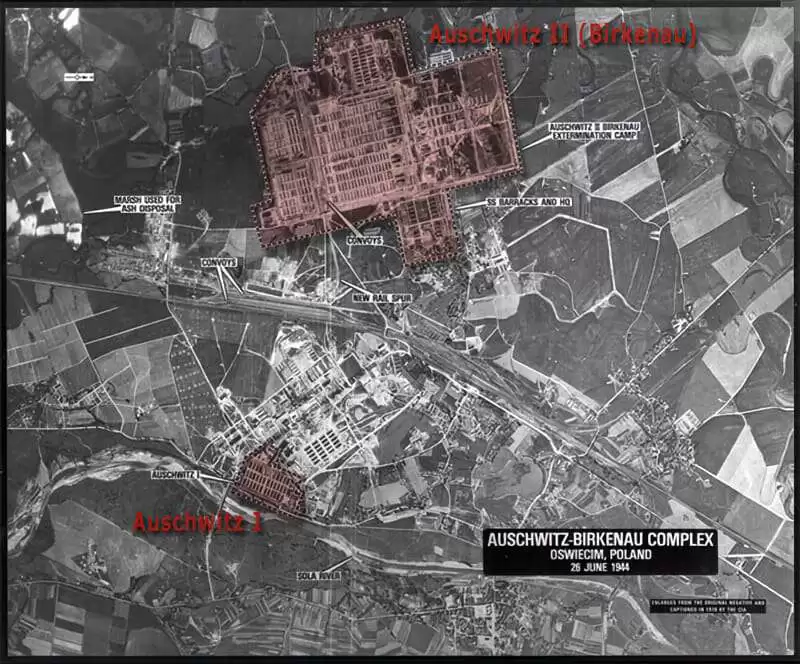
The majority of the Jewish deportees died in the gas chambers immediately after arrival. Of the estimated 400,000 people who were placed in the main concentration camp or one of the sub-camps, less than half survived.
The camp continued operation till its liberation by the Soviet Army in January 1945.
For more information about the history of Auschwitz, visit this [ link ] on the Auschwitz Museum website.
Today, the site is managed by the Auschwitz-Birkenau State Museum in Poland which, in addition to maintaining the camps and providing visitor support, is also a very large research and publications center. Over 25 million people have visited the Auschwitz Museum since its establishment in 1947.
This virtual tour of both camps tries to give viewers a first-hand experience of visiting the actual sites. The photographs were taken in 2003 and 2004, by Alan Jacobs .
About the Virtual Tour of Auschwitz Exhibition
The project was conceived some years ago when Alan (“Jake”) Jacobs first saw Quick Time Virtual Reality Films. Having photographed Auschwitz many times, it occurred to him that no matter how powerful a single photo, the observer is still outside the scene. This technology provided an opportunity for a photographer to lessen to some degree the viewer’s role as audience-observer, and enhance his perception as a participant-observer. As he already had a 35mm single-lens-reflex digital camera, a Canon D60, the next step was to purchase a solid tripod, and a Manfrotto Quick Time Virtual Reality Head, and practice, using a Canon EOS EF 17-35/2.8L USM wide angle zoom lens set to its widest at 17mm.
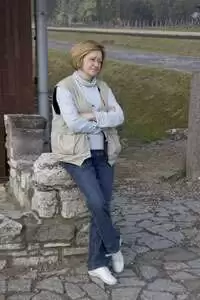
Krysia in Birkenau
Next Jake’s wife Krysia, the technical part of the team, purchased VR Worx, a program that stitched multiple photos, took out what wasn’t necessary, adjusted exposure from photo to photo, and produced in a very short time, maybe ten or fifteen minutes, a virtual reality 360º film. The photos were processed before this in full Photoshop on a variety of Macs.
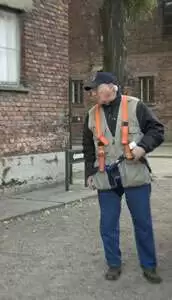
Jake preparing to take aerial photographs in Auschwitz I
They went back to Auschwitz in 2003 and did some test shots with a Canon EOS 1D 35mm digital SLR and an EF 16-35mm f/2.8L USM wide angle lens set to 16mm. While there, they checked with Editor in Chief of Auschwitz Publications, Teresa Swiebocka, who introduced them to senior editor Jarek Mensfelt.
Both were interested and over the next few months test shots were sent and the invitation to come and do the work was made by Auschwitz Vice-Director, Krystyna Oleksy, this to share an exhibition jointly with Remember.org – Cybrary of the Holocaust.
Then it was a matter of getting expense money. Jake spoke with Michael Declan Dunn the creator of The Cybrary of the Holocaust. Michael has published several exhibitions of Jake’s Auschwitz photos and he set to work raising the money. He found two donors, Liz Edlic, Scott Isdaner, whose grants made the project possible.
From the time of the invitation through the shoot at the camps, Auschwitz Editor and web designer Jarek Mensfelt and Jake exchanged many ideas about the project: tone, content, logistics etc. During the shoot an EOS 1D Marc II, a 35mm digital SLR, and Canon EF 16-35mm f/2.8L USM, Canon EF 28-135 USM IS, Canon EF 70-200mm f2.8L USM lenses were used, along with a Canon EF 14mm f/2.8L USM Wide Angle Lens. Returning to the States, the project was now in the hands of Krysia Jacobs. This meant processing the photos in Photoshop CS, stitching them with VR Work 2.5, converting to Flash with qtvr2flash, and then… designing the exhibition for the Internet. The following equipment was used in taking the photographs:
- Canon EF 14mm f/2.8L USM Wide Angle Lens
- Canon EOS EF 17-35/2.8L USM
- Canon EF 16-35mm f/2.8L USM
- Canon EF 70-200mm f2.8L USM
- Canon EOS 1D Marc II 35mm digital SLR
- Canon EOS 1D 35mm digital SLR
For more info please visit the Virtual Tour Credits .
Then and Now - paintings by survivors from experience with photos today of where they remember.
Then and now 3 | auschwitz birkenau daily life, then and now 2 | birkenau panorama of the camp, then and now auschwitz paintings by survivors and recent photos, alan jacobs.
Photographs taken in Auschwitz and Birkenau in the years 2003-2004 , then converted into a VR presentation with QuickTime, now updated to a video based Virtual Tour. © 2003, 2004 Alan Jacobs all rights reserved Credits Photographs and Captions: Alan Jacobs Photoshop, QuicktimeVR & Flash processing: Krysia Jacobs On Site Support and Consulting Jarek Mensfelt, Auschwitz-Birkenau State Museums This exhibition was prepared by invitation from Auschwitz-Birkenau State Museum, Oswiecim, Poland Deputy Director: Krystyna Oleksy Editor in Chief: Teresa Swiebocka
Remember. Zachor. Sich erinnern.
Remember.org helps people find the best digital resources, connecting them through a collaborative learning structure since 1994. If you'd like to share your story on Remember.org, all we ask is that you give permission to students and teachers to use the materials in a non-commercial setting. Founded April 25, 1995 as a "Cybrary of the Holocaust". Content created by Community. THANKS FOR THE SUPPORT . History Channel ABC PBS CNET One World Live New York Times Apple Adobe Copyright 1995-2024 Remember.org. All Rights Reserved. Publisher: Dunn Simply
APA Citation
Dunn, M. D. (Ed.). (95, April 25). Remember.org - The Holocaust History - A People's and Survivors' History. Retrieved February 28, 2022, from remember.org
MLA Citation


These educational Holocaust videos explore the experiences of Holocaust survivors, the Museum’s collections, and Holocaust history.
This 38-minute film examines the Nazis’ rise and consolidation of power in Germany. It also outlines the path by which the Nazis and their collaborators led a state to war and to the murder of millions of people.
This 13-minute film introduces the history of antisemitism from its origins in the days of the early Christian church until the era of the Holocaust in the mid-20th century. It raises questions about why Jews have been targeted throughout history.
This 40-minute film tells Gerda Weissmann’s account of surviving the Holocaust, based off her book All but My Life . It was produced in 1995 by HBO and the Museum to commemorate the the 50th anniversary of the end of the Holocaust.
This film series explores the details and history behind items in the Museum’s collections. Through interviews with Museum curators and experts, these videos highlight the work the Museum does to collect and preserve evidence of the Holocaust.
Hear Holocaust survivors tell their life stories in their own words, uniting personal experience with history. Each hour-long program features a live interview between journalist Bill Benson and a survivor.
This 16-minute film looks at American responses to the persecution and murder of European Jews during the Holocaust.
This 11-minute film examines early warning signs that led to the Holocaust. Reflecting on these events challenges us to consider what might motivate us to respond to indicators of genocide today.
The trials at Nuremberg and the trial of Adolf Eichmann set important precedents and raised questions about the nature of justice in the face of such enormous crimes. This 10-minute film focuses on the ways crimes were documented, the trials, and their legacy of justice.
This 14-minute film shows the realities of liberation. The US soldiers who helped defeat Nazi Germany and liberate the concentration camps were among the first eyewitnesses to the Holocaust.
This 12-minute film, originally created as a way to commemorate Days of Remembrance, tells the stories of ordinary people who chose to intervene and help rescue Jews, despite the risks.
These videos explore different aspects of Wiesel’s impact and legacy through the voices of many of those who knew him best.
The Museum’s YouTube channel includes educational films, documentaries, programs held at the Museum, survivor testimony, and more. Browse selected Holocaust videos and playlists below.
• Stay Connected: Lessons of the Holocaust • Survivors Remember Kristallnacht • Nazi Olympics: Berlin 1936 • Jewish Life Before World War II
This Section
Explore lesson plans and training materials organized by theme to use in your classroom.
- Online Tools for Learning and Teaching
- Videos for Classroom Use
Take advantage of the search to browse through the World Heritage Centre information.
Share on social media
Unesco social media, auschwitz birkenau german nazi concentration and extermination camp (1940-1945).
- Description

UNESCO/NHK Videos on Heritage
- South Africa
- El Salvador
- Bosnia and Herzegovina
- North Macedonia
- Czech Republic
- Transnistria
- Liechtenstein
- North Cyprus
- New Zealand
- Map with posts
- Alternative Guides
- Architecture Guides
- Cafe Guides
- Itineraries
- Neighborhood Guides
- Travel Guides
- Travel Tips
- Photo Galleries
- Photo Locations
- Solo female travel
- Train Travels
- Work with me
- Privacy Policy
Visiting Auschwitz – How to Plan the Auschwitz Tour
Visiting Auschwitz, albeit a very somber experience, is one of the must things to do in Poland. The largest Nazi Germany concentration and extermination camp during World War II, where over 1,3 million people lost their lives, needs no introduction. Conveniently located near Krakow , Auschwitz can be an easy addition to your Poland itinerary.
It took me almost 37 years to finally visit Auschwitz (although I’ve been to other Nazi Germany camps in Poland), and even if I knew very well what to expect, the place still overwhelmed me with its cruelty and tragedy. And I think everyone should plan a trip to Auschwitz to understand history better and see what people are capable of when the ideology brainwashes them. And, of course, to pay respect to all the unnecessary victims. It’s important to visit places like Auschwitz so we can do our best to prevent similar tragedies from happening in the future.

If you are visiting Poland (especially Krakow , Warsaw , Katowice , or Wroclaw ), I prepared this guide to help you plan your Auschwitz tour without too much hassle. There are different ways to visit Auschwitz, but no matter which one you choose, be prepared for one of the most difficult yet necessary travel experiences of your life.

Table of Contents
Where is Auschwitz
The former Nazi Germany Concentration Camp, Auschwitz-Birkenau, is located in a town of around 37.000 inhabitants called Oświęcim in southern Poland. Krakow is less than 70 km away, and Katowice is 35 km away. Warsaw, the capital of Poland, is around 330 km away from Oświęcim.
A brief history of Auschwitz
Even if Auschwitz is known mainly as the extermination camp, it was established as a concentration camp in mid-1940. It was one of over 40 camps in Poland that were supposed to be a solution to the problem of overflowing prisons full of arrested locals. The first people were brought to Auschwitz on June 14th, 1940, from the prison in Tarnow.
Since 1942 Auschwitz has also been used as the extermination camp where Nazis implemented their plan to murder Jewish people from all over Europe. At the peak of its operation, in 1944, Auschwitz was divided into three parts: Auschwitz I (the oldest one, in the old Polish military barracks), Auschwitz II-Birkenau (the largest one, founded in 1941, the majority of victims were killed here), and Auschwitz III (this was a group of over 40 sub-camps created near industrial plants, made for work prisoners).
Numerous Polish villages were demolished, and locals were evicted to develop such a large institution. The camps were isolated from the outside world. The total area was around 40 square kilometers, including all three Auschwitz camps and the so-called “interest zone” used for the technical or supply background, offices, and barracks for Nazis.
Since Auschwitz had a strategic location on the front line, in August 1944, the camp’s liquidation began – the prisoners were taken to Germany, and the evidence of the crimes was covered up. The liberation of Auschwitz took place on January 27th, 1945, when around 7,5 thousand prisoners were still held there.
Altogether, in the almost four years of operation, over 1,3 million people lost their lives in Auschwitz; the majority were Jewish (around 1,1 million), but also Polish (about 150 hundred thousand), Roma people (23 thousand), and other nations.
In 1979 Auschwitz was included in the UNESCO World Heritage List – it is the only former Nazi concentration camp with that title in the world.
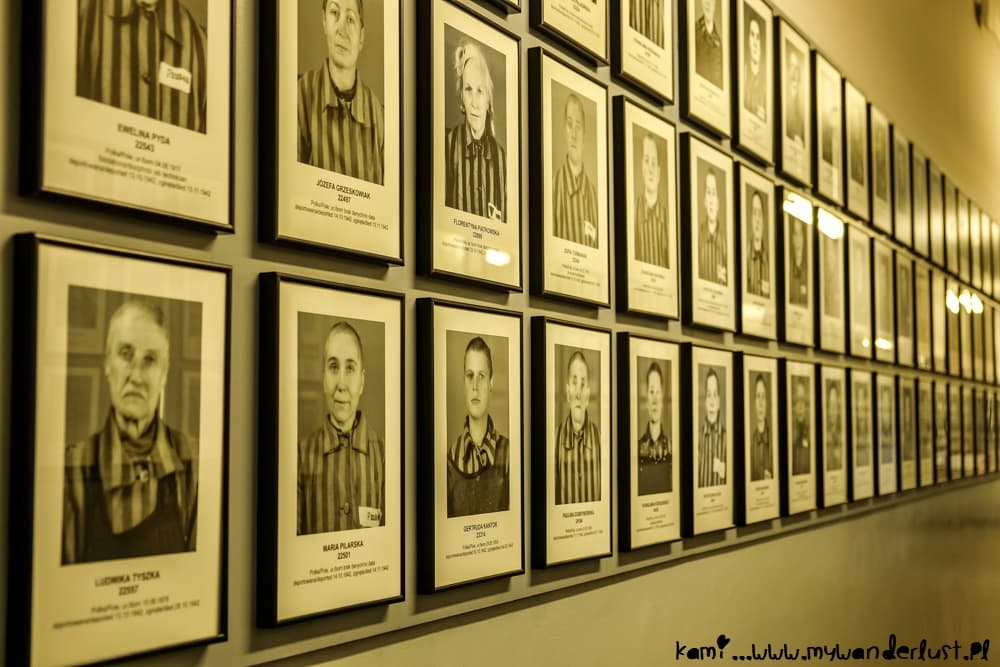
How to visit Auschwitz
You can visit Auschwitz two ways: with a tour from where you are staying in Poland (most likely Krakow, Katowice, Warsaw, or Wroclaw) or independently, reaching the site by car or using public transport. Both options are doable; however, the tour is a slightly better one as everything will be taken care of for you.
There is a wide selection of tours to choose from that depart from Krakow as well as other mentioned cities. Most of them cover more or less the same things: pick-up from your accommodation, transportation to/from Auschwitz and back, the entrance ticket to the concentration camp, and the guided tour on-site.
When I visited Auschwitz, I arrived by train from Warsaw, with the change in Katowice. I was at the museum almost an hour before my guided tour of the site was supposed to start, and despite the poor weather (it was raining on that day), there was no place to hide and wait for the tour. Visitors were not allowed to enter the museum until a few minutes before the tour was about to start. Me and a few other unlucky visitors just stood near the trees, hiding under the umbrella and waiting for our time to enter the site. I can’t say it was a comfortable situation (but at least the weather worked perfectly well for such a sad place to visit). Recently, a new visitors center was opened so hopefully the situation is better.
When using public transport, you need to rely on the schedule of trains/buses and, just in case, plan to be at the site with some extra time ahead; hence a tour is a better option. Still, visiting Auschwitz is doable independently – I did it, and once the tour of the site started, it was really good.

Visiting Auschwitz – practical information
Visiting Auschwitz memorial site is free of charge; however, I recommend joining the tour with the educator provided by the museum. They have a huge knowledge of the place and the tragedy that occurred here and can answer all the questions visitors always have. Tours are available in various languages: Polish, English, German, French, Spanish, Italian, Russian, Czech, and Slovak.
Even if you decide to visit the site independently, you still need to book the entry pass – those with free entrance start in the afternoon. You can buy/reserve your ticket online at the website of Auschwitz Museum here.
Currently, the price for the tour with the educator is 80 PLN for Polish and 90 PLN for other languages. When booking the ticket, you must state your full name and surname – this will be checked later.
Since tickets can sell out quickly, booking one at least a month in advance is recommended. If there are no tickets left for the day you want to visit Auschwitz, you can join the organized tour from Krakow or other cities, as tour operators usually have tickets booked in advance. Due to the sensitive nature of the place, children under 14 years old should not visit Auschwitz Museum.
Once you have your ticket, you need to arrive at the Auschwitz visitors center 30 minutes before your tour starts to go through the security check (it’s rather thorough, similar to the airport), have your ticket inspected (remember to have the ID or passport with you), get the headset for the tour and meet your group. You are allowed to have a bag or backpack with a maximum dimension of 30x20x10 cm; any larger luggage must be left in the paid lockers.
Auschwitz Museum is open every day except January 1st, December 25th, and Easter Sunday. Opening hours vary depending on the month and are as follows:
- 7:30-14:00 in December
- 7:30-15:00 in January and November
- 7:30-16:00 in February
- 7:30-17:00 in March and October
- 7:30-18:00 in April, May, and September
- 7:30-19:00 in June, July, and August
The closing time means the last entrance – after that, you are allowed to stay on-site for an hour and a half. However, if you want to see Auschwitz Museum properly, you need at least 3,5 hours for that – that’s also how long the standard tour with the educator lasts. It is usually divided equally between Auschwitz I and Auschwitz II- Birkenau. A free shuttle bus runs between the two sites every few minutes.
Taking pictures and making videos is allowed in Auschwitz, for individual use, except in two places: the hall with the hair of Victims (block nr 4) and the basements of Block 11. Your educator will remind you not to take pictures there.
Remember what sort of place you are visiting and behave there with respect. It might be obvious for most, but I can’t count how many times I’ve read news about inappropriate behavior in Auschwitz and other similar sites in Poland, so I think it’s worth reminding this is not your typical tourist attraction but a place of one of the greatest tragedy that ever happened in the world.

Getting to Auschwitz independently
If you decide to visit Auschwitz on your own, you must get to the visitors’ center, where your tour will start. The new visitors center, which opened just recently, is located at 55 Więźniów Oświęcimia Street in Oświęcim ( here is the exact location ). If you drive there, there is a large parking lot where you can leave your car before visiting the museum.
If you use public transport, there are both trains and buses you can take to reach Oświęcim. I recommend trains as they are slightly faster and more comfortable; however, some buses stop next to the museum, so that’s convenient. You can check all the connections on this website , where you can also find the location of the bus stop in Oświęcim (there can be three different ones).
The train station in Oświęcim is located at Powstańców Śląskich Street, some 20 minutes walking from the Auschwitz museum. It’s a straightforward way; you can check the map with the directions here . I recommend catching the train that gives you at least an hour between arriving at Oświęcim and when your tour starts.

Auschwitz tour from Krakow
Numerous Auschwitz tours depart from Krakow, so you will easily find the one that suits your itinerary and needs. Here are some recommended ones:
- Auschwitz-Birkenau Museum and Memorial Guided Tour from Krakow
- Auschwitz & Birkenau – Fully Guided Tour from Krakow
- Auschwitz-Birkenau Guided Tour with Private Transport from Kraków
- Auschwitz-Birkenau Guided Tour by Private Transport from Krakow
You can also combine visiting Auschwitz with Wieliczka Salt Mine , another UNESCO-listed site near Krakow and a must-visit place in Poland. Here are the tours that go to both places in one day:
- Day Trip to Auschwitz-Birkenau and Wieliczka Salt Mine from Krakow including Lunch
- Full-Day Tour of Auschwitz and Wieliczka Salt Mine from Krakow
- Auschwitz-Birkenau and Salt Mine Tour with private transport from Krakow
- Combined: Auschwitz Birkenau and Salt Mine private chauffeur from Krakow
If you decide to go to Auschwitz from Krakow on your own, you can take the train from the main train station to Oświęcim. They are rather frequent, more or less every hour, and the journey takes a bit over an hour (depending on the connection, the longest one is 1h20min).
If you want to take the bus, they depart from the MDA bus station, next to the main train station. The price for trains and buses is similar, between 15 and 20 PLN, although trains tend to be cheaper and faster. You can check all the connections and buy a ticket here .

Auschwitz tour from Warsaw
Even if Warsaw, the capital of Poland, is located over 300 km away from Oświęcim, it is possible to go for a one-day Auschwitz tour. However, you can expect a long day, and a large part of it will be spent traveling. But if you are visiting Warsaw only, Auschwitz can be a good addition to your Poland itinerary, so you can better understand the country’s complex history.
Here are some of the recommended Auschwitz tours from Warsaw:
- From Warsaw Auschwitz and Krakow one day tour by train with pick up and drop off
- One day tour to Auschwitz-Birkenau from Warsaw with private transport
Going for the day trip from Warsaw to Auschwitz independently is also possible using trains. You can take the 6 am train to Katowice and then change for the train to Oświęcim, arriving in the town around 10:30. If you decide to do that, you can book your Auschwitz tour for 11:30 or 12:00. On the way back, you can catch the train after 16:00 from Oświęcim to Katowice, and after changing for the train to Warsaw, you will be in the capital after 20:00.

Auschwitz tour from Katowice
Since Katowice is less than 40 km from Auschwitz, it’s easy to go for a day trip. You need to take the local train to Oświęcim, it takes less than 50 minutes, and the connections are more or less every hour.
Or you can go for a tour, here are the Auschwitz tours from Katowice:
- Auschwitz – Birkenau from Katowice
- Auschwitz & Birkenau English guided tour by private transport from Katowice
- Auschwitz tour from Wroclaw
Wroclaw is another popular place to visit in Poland, and since it’s located around 230 km from Oświęcim, you can go for an Auschwitz tour from Wroclaw too. If you decide to do it independently, you can take the train to Katowice and then change for the local train to Oświęcim. A one-way trip should take you less than 4 hours.
Or you can go for a tour; here are the recommended ones from Wroclaw:
- Auschwitz-Birkenau Tour from Wrocław
- Private Full-Day Tour to Auschwitz-Birkenau from Wroclaw
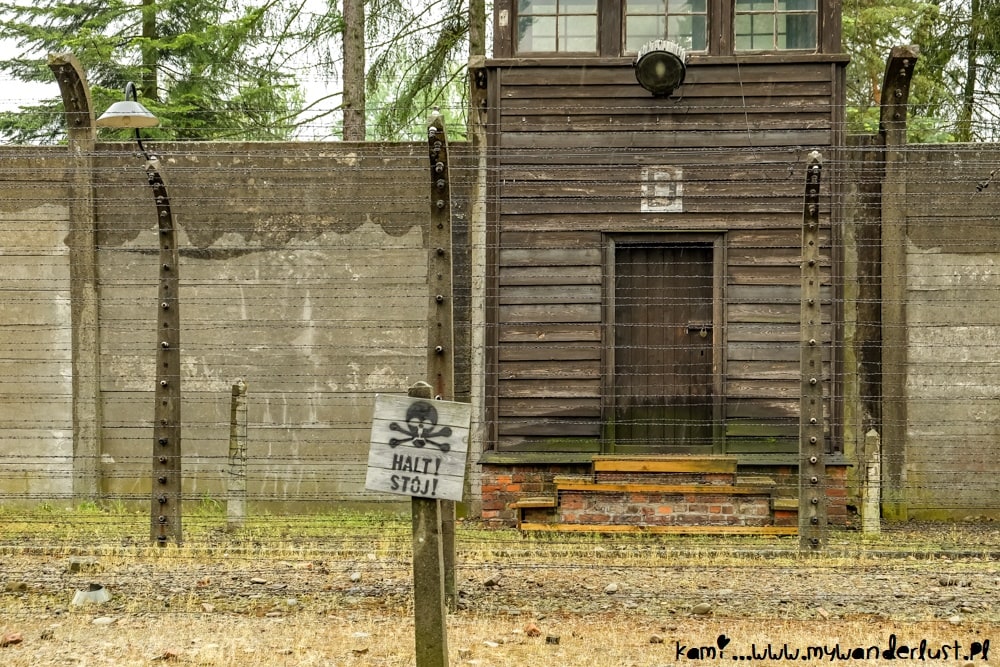
Auschwitz Museum Tour
As for the museum itself, here is what you can expect.
You will start in the oldest part of the concentration camp – Auschwitz I, where the infamous gate with the sign “Arbeit macht frei” (meaning “Work Sets You Free”) is located. Here, you will visit numerous barracks where inmates were kept – now you can see different exhibitions there, showing the reality of Auschwitz and halls with personal belongings taken from arriving prisoners – luggage, shoes, glasses, etc., or hair of Victims. You will learn all about cruel practices here, including medical experiments or torture.
Visiting this part of Auschwitz museum is a very somber experience, and it’s really difficult to comprehend the tragedy that happened in this very place.
Besides the barracks in Auschwitz I, you will also see where the camp commander lived or the first crematorium where Nazis started their experiments with killing using gas. In this part of the Auschwitz tour, you can take pictures everywhere except the two places in Blocks 4 and 11 – they will be clearly marked, and your educator will remind you about this restriction.
The visit to Auschwitz I takes around 1,5 hours. Afterward, together with your group and educator, you will take the shuttle bus to Auschwitz II-Birkenau, located some 3 km away.

Auschwitz II-Birkenau is where around 90% of victims died. It is a huge area that worked kind of like the killing factory, with four gas chambers and crematoriums. This is also where most prisoners arrived – you most likely know the view of the railway tracks and brick gate – that’s Auschwitz II-Birkenau. This part of the visit is mostly outdoors.
You will walk around the area, see the remnants of the camp, visit some barracks inside, and learn all about the horrific tragedy that happened here. When Auschwitz I has a more intimate, even claustrophobic feeling, Auschwitz II-Birkenau can overwhelm you with its scale and enormity.
You will spend around 1,5 hours here, too; afterward, you can take the shuttle bus back to the visitors center when you started your tour.
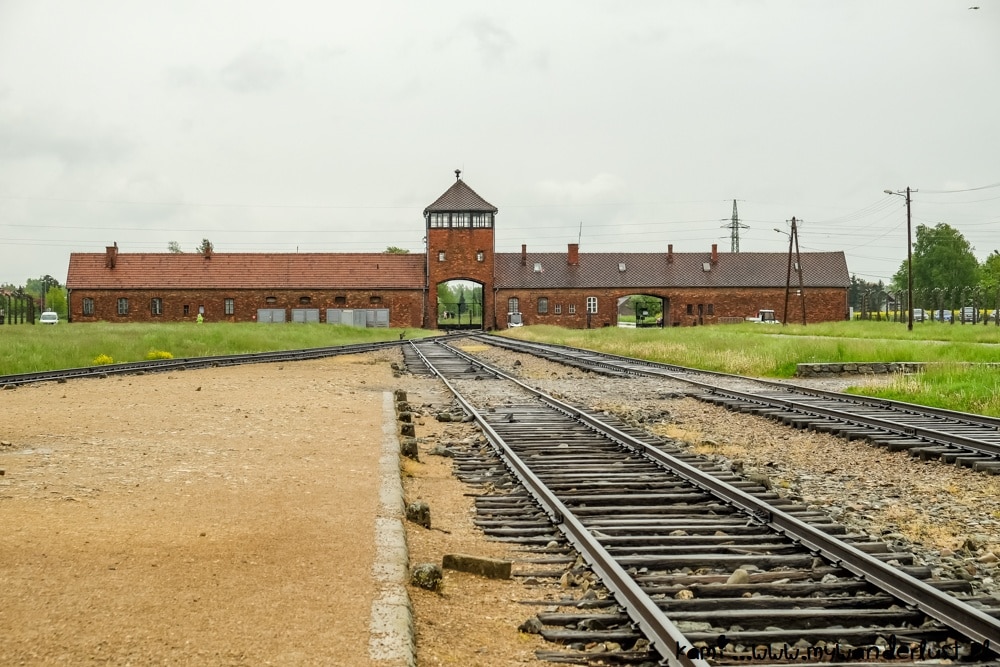
Final thoughts on visiting Auschwitz
Even though I’ve lived in Poland almost my whole life, and Auschwitz has been a familiar topic since I remember, it took me nearly 37 years to finally visit the place. Before I was in different Nazi Germany sites in Poland, mostly in Majdanek in Lublin, so I didn’t feel the need to visit Auschwitz too. But I don’t regret the decision to go there eventually.
You can read and learn about the place, but nothing can prepare you for visiting Auschwitz. Some areas look familiar (after all, pictures of the “Arbeit macht frei” sign or Birkenau gate are present everywhere), but you will still be overwhelmed by the place and seeing it in real life. It’s hard to comprehend the cruelty and tragedy that happened here, and dealing with all the thoughts invading your mind afterward can take a while. It can be one of the most difficult-to-understand places you will ever visit.
Still, despite it all, I think everyone should go to Auschwitz to see where fanaticism and totalitarianism can lead and why we should avoid them at all costs.
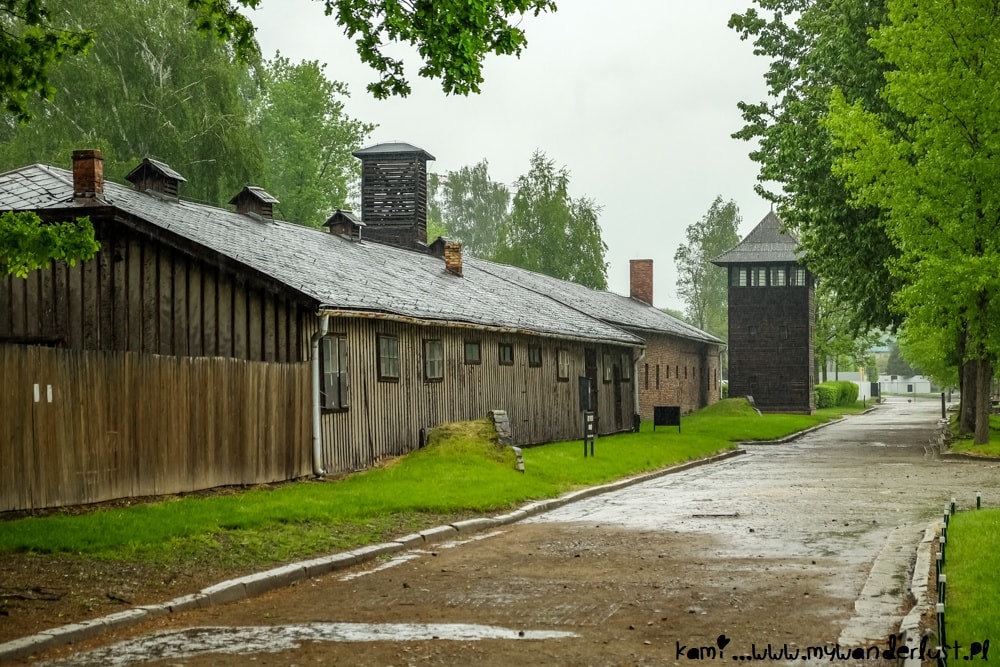
Travel Resources
You can find the best accommodation options at Booking . They have many discounts and excellent customer service. Click here to look for the place to stay in Poland
Never travel without travel insurance , you never know what might happen and better safe than sorry. You can check the insurance policy for Poland here.
I recommend joining organized tours to get to know the place better and to visit more places during your trip. You can find a great selection of tours at Get Your Guide – click here .
For the end I left a few announcements that might interest you:
- Sign up to my newsletter or follow me on Bloglovin to get updates about the new posts
- Join my Facebook group about Eastern Europe, the Balkans and former USSR and connect with fellow travellers and enthusiasts of these regions – just click here!
- I’ve included a few handy links of services and products I personally like and use so you can plan your own trip to Poland too. They are often affiliate links. This means I will get a small commission if you book/purchase anything through my links, at no extra costs for you. Thank you!
LIKED IT? PIN THIS POST FOR LATER!
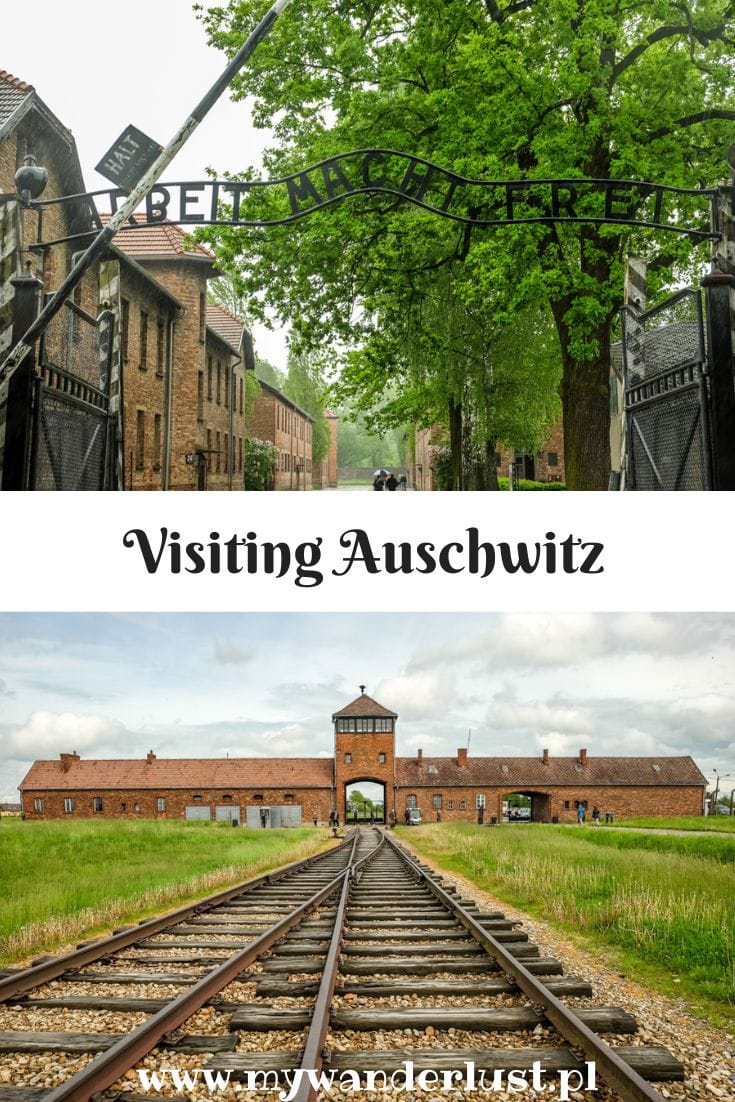
If you enjoyed that post why don't you share it with your friends? That would mean so much to me! Also be sure to join 30.000+ fellow travelers and follow me on Facebook , Twitter , or Instagram for travel updates and even more pictures! If you don't want to miss new posts sign up to my newsletter or follow on Bloglovin !

No Comments
Leave a reply cancel reply.
Sign me up for the newsletter!
Let’s become friends!
Join me on Facebook for even more travel updates!
Kami and the rest of the world
- History Classics
- Your Profile
- Find History on Facebook (Opens in a new window)
- Find History on Twitter (Opens in a new window)
- Find History on YouTube (Opens in a new window)
- Find History on Instagram (Opens in a new window)
- Find History on TikTok (Opens in a new window)
- This Day In History
- History Podcasts
- History Vault
By: History.com Editors
Updated: January 24, 2024 | Original: December 15, 2009

Auschwitz, also known as Auschwitz-Birkenau, opened in 1940 and was the largest of the Nazi concentration and death camps. Located in southern Poland, Auschwitz initially served as a detention center for political prisoners. However, it evolved into a network of camps where Jewish people and other perceived enemies of the Nazi state were exterminated, often in gas chambers, or used as slave labor. Some prisoners were also subjected to barbaric medical experiments led by Josef Mengele (1911-79). During World War II (1939-45), more than 1 million people, by some accounts, lost their lives at Auschwitz.
In January 1945, with the Soviet army approaching, Nazi officials ordered the camp abandoned and sent an estimated 60,000 prisoners on a forced march to other locations. When the Soviets entered Auschwitz, they found thousands of emaciated detainees and piles of corpses left behind.
Auschwitz: Genesis of Death Camps
After the start of World War II , Adolf Hitler (1889-1945), the chancellor of Germany from 1933 to 1945, implemented a policy that came to be known as the “Final Solution.” Hitler was determined not just to isolate Jews in Germany and countries annexed by the Nazis, subjecting them to dehumanizing regulations and random acts of violence. Instead, he became convinced that his “Jewish problem” would be solved only with the elimination of every Jew in his domain, along with artists, educators, Romas, communists, homosexuals, the mentally and physically handicapped and others deemed unfit for survival in Nazi Germany.
Did you know? In October 1944, a group of Auschwitz "Sonderkommando," young Jewish males responsible for removing corpses from crematoriums and gas chambers, staged a revolt. They assaulted their guards, using tools and makeshift explosives, and demolished a crematorium. All were apprehended and killed.
To complete this mission, Hitler ordered the construction of death camps. Unlike concentration camps, which had existed in Germany since 1933 and were detention centers for Jews, political prisoners and other perceived enemies of the Nazi state, death camps existed for the sole purpose of killing Jews and other “undesirables,” in what became known as the Holocaust.
Auschwitz: The Largest of the Death Camps
Auschwitz, the largest and arguably the most notorious of all the Nazi death camps, opened in the spring of 1940. Its first commandant was Rudolf Höss (1900-47), who previously had helped run the Sachsenhausen concentration camp in Oranienburg, Germany. Auschwitz was located on a former military base outside Oswiecim, a town in southern Poland situated near Krakow, one of the country’s largest cities. During the camp’s construction, nearby factories were appropriated and all those living in the area were forcibly ejected from their homes, which were bulldozed by the Nazis.
Auschwitz originally was conceived as a concentration camp, to be used as a detention center for the many Polish citizens arrested after Germany annexed the country in 1939. These detainees included anti-Nazi activists, politicians, resistance members and luminaries from the cultural and scientific communities. Once Hitler’s Final Solution became official Nazi policy, however, Auschwitz was deemed an ideal death camp locale. For one thing, it was situated near the center of all German-occupied countries on the European continent. For another, it was in close proximity to the string of rail lines used to transport detainees to the network of Nazi camps.
However, not all those arriving at Auschwitz were immediately exterminated. Those deemed fit to work were employed as slave labor in the production of munitions, synthetic rubber and other products considered essential to Germany’s efforts in World War II.
Auschwitz and Its Subdivisions
At its peak of operation, Auschwitz consisted of several divisions. The original camp, known as Auschwitz I, housed between 15,000 and 20,000 political prisoners. Those entering its main gate were greeted with an infamous and ironic inscription: “Arbeit Macht Frei,” or “Work Makes You Free.”
Auschwitz II, located in the village of Birkenau, or Brzezinka, was constructed in 1941 on the order of Heinrich Himmler (1900-45), commander of the “Schutzstaffel” (or Select Guard/Protection Squad, more commonly known as the SS), which operated all Nazi concentration camps and death camps. Birkenau, the biggest of the Auschwitz facilities, could hold some 90,000 prisoners.
It also housed a group of bathhouses where countless people were gassed to death, and crematory ovens where bodies were burned. The majority of Auschwitz victims died at Birkenau. More than 40 smaller facilities, called subcamps, dotted the landscape and served as slave-labor camps. The largest of these subcamps, Monowitz, also known as Auschwitz III, began operating in 1942 and housed some 10,000 prisoners.
Life and Death in Auschwitz
By mid-1942, the majority of those being sent by the Nazis to Auschwitz were Jews. Upon arriving at the camp, detainees were examined by Nazi doctors. Those detainees considered unfit for work, including young children, the elderly, pregnant women and the infirm, were immediately ordered to take showers. However, the bathhouses to which they marched were disguised gas chambers. Once inside, the prisoners were exposed to Zyklon-B poison gas. Individuals marked as unfit for work were never officially registered as Auschwitz inmates. For this reason, it is impossible to calculate the number of lives lost in the camp.
For those prisoners who initially escaped the gas chambers, an undetermined number died from overwork, disease, insufficient nutrition or the daily struggle for survival in brutal living conditions. Arbitrary executions, torture and retribution happened daily in front of the other prisoners.
Some Auschwitz prisoners were subjected to inhumane medical experimentation. The chief perpetrator of this barbaric research was Josef Mengele (1911-79), a German physician who began working at Auschwitz in 1943. Mengele, who came to be known as the “Angel of Death,” performed a range of experiments on detainees. For example, in an effort to study eye color, he injected serum into the eyeballs of dozens of children, causing them excruciating pain. He also injected chloroform into the hearts of twins to determine if both siblings would die at the same time and in the same manner.
Liberation of Auschwitz: 1945
As 1944 came to a close and the defeat of Nazi Germany by the Allied forces seemed certain, the Auschwitz commandants began destroying evidence of the horror that had taken place there. Buildings were torn down, blown up or set on fire, and records were destroyed.
In January 1945, as the Soviet army entered Krakow, the Germans ordered that Auschwitz be abandoned. Before the end of the month, in what came to be known as the Auschwitz death marches, an estimated 60,000 detainees, accompanied by Nazi guards, departed the camp and were forced to march to the Polish towns of Gliwice or Wodzislaw, some 30 miles away. Countless prisoners died during this process; those who made it to the sites were sent on trains to concentration camps in Germany.
When the Soviet army entered Auschwitz on January 27, they found approximately 7,600 sick or emaciated detainees who had been left behind barbed wire. The liberators also discovered mounds of corpses, hundreds of thousands of pieces of clothing and pairs of shoes and seven tons of human hair that had been shaved from detainees before their liquidation. According to some estimates, between 1.1 million to 1.5 million people, the vast majority of them Jews, died at Auschwitz during its years of operation. An estimated 70,000 to 80,000 Poles perished at the camp, along with 19,000 to 20,000 Romas and smaller numbers of Soviet prisoners of war and other individuals.
Auschwitz Today
Today, Auschwitz is open to the public as the Auschwitz-Birkenau Memorial and Museum . It tells the story of the largest mass murder site in history and acts as a reminder of the horrors of genocide.
Images from the Death Camps


Sign up for Inside History
Get HISTORY’s most fascinating stories delivered to your inbox three times a week.
By submitting your information, you agree to receive emails from HISTORY and A+E Networks. You can opt out at any time. You must be 16 years or older and a resident of the United States.
More details : Privacy Notice | Terms of Use | Contact Us
Advertisement
A new Holocaust exhibit in Boston confronts a painful history
- Arielle Gray
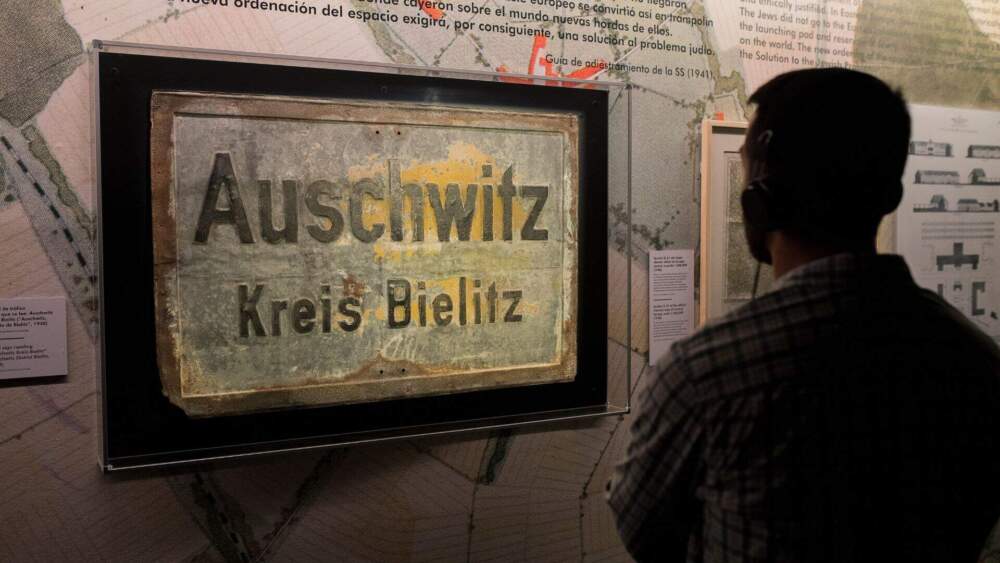
Nearly 80 years ago, World War II was finally coming to an end. In January of 1945, the largest Nazi concentration camp, Auschwitz, was liberated by the Soviet army — around 7,000 people were freed, though many would later die due to malnutrition and other medical complications.
And liberation came too late for the 1.1 million people whose lives were claimed by Auschwitz in the years it operated.
For the first time, hundreds of Holocaust artifacts are in Boston as a part of the international exhibition, “ Auschwitz. Not Long Ago. Not Far Away .”
Running through Sept. 2 at Saunders Castle at Park Plaza, the exhibit explores the painful legacy of one of history’s darkest chapters.
Created by Spanish company Musealia in collaboration with Auschwitz-Birkenau Memorial, “Auschwitz. Not Long Ago. Not Far Away” comes at a time when religious and racial tensions are high. This is the first traveling exhibition on Auschwitz.

“An exhibition this substantial and comprehensive on Auschwitz ... is unlikely to ever be assembled again,” said Luis Ferreiro, director of Musealia.
Seven years ago, he was inspired to explore the idea of an exhibit after reading "Man's Search for Meaning," a book that chronicles author Viktor Frankl's time spent in Nazi concentration camps. Frankl and his family were sent to Auschwitz.
“Listening to their stories and understanding how these events could happen is the best action we, as citizens of the world, can take against the reoccurrence of such a horrific event,” Ferreiro said.
This is the first time a collection of this size has been brought together to tell the story of the Holocaust — the exhibit features 700 artifacts from the Auschwitz-Birkenau Memorial and over 20 other museums. Objects include materials and suitcases packed by Auschwitz deportees, a gas mask and even large portions of an original prisoner’s barrack.
“These artifacts call upon guests to prevent the dehumanization of others by building a future free from antisemitism, racism and all ideologies of hatred,” said Piotr Cywinski, director of the Auschwitz-Birkenau Memorial.
Upon entering "Auschwitz. Not Long Ago. Not Far Away," visitors are guided chronologically through the exhibit via an audio-tour device, starting with an exploration of how so many people bought into genocidal, anti-Semitic, racist political rhetoric.
Founded in 1919, the National Socialist German Workers’ Party, or the Nazi party, helmed by Adolf Hitler, would go on to kill an estimated six million Jewish people under the guise of restoring the German nation to its former glory. The total number of people killed throughout the Holocaust, including other minority groups and prisoners of war, is closer to 11 million.
Auschwitz was the largest of the many concentration camps established by the Nazis after the beginning of World War II. It received its first detainees in 1940 and operated for five years until 1945.
Before Soviet forces liberated Auschwitz in January, nearly 60,000 prisoners were forced on death marches. Around 15,000 people died on those marches. The war would eventually end months later in May when German forces surrendered in Berlin.
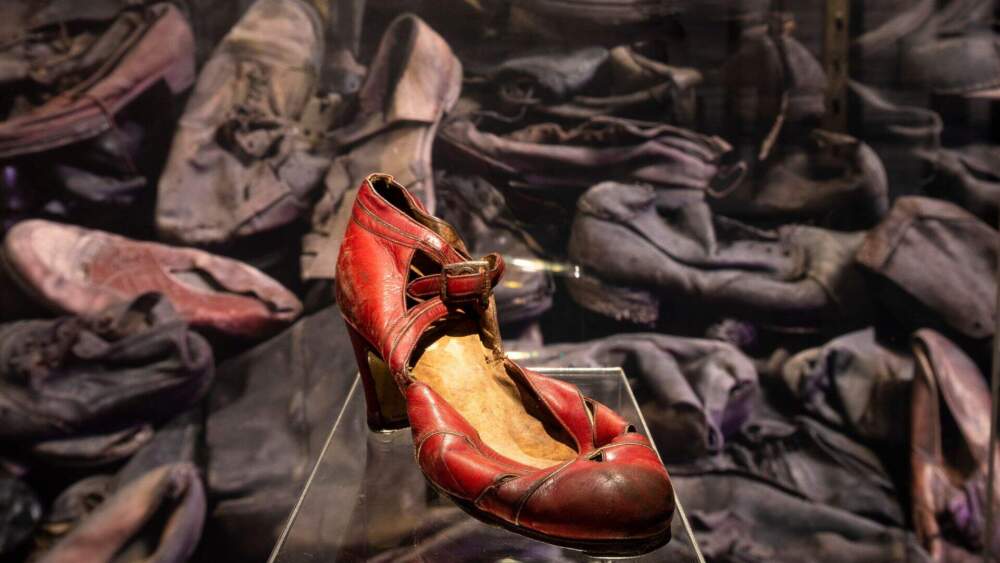
Divided into four parts, co-curator Paul Salmons says this exhibition "will show objects related to the perpetrators themselves... it shows the personal items of the victims and tells the stories of the individual people, the families that were torn apart, the communities that were devastated."
Items, like a bright red woman's shoe and a child's doll, bring detail to the lives of those killed at Auschwitz. They help concretize and contextualize a history that many have only experienced through history books. Other objects, like the barracks and operating table, underscore the dehumanization necessary to commit such atrocities like the ones that happened at Nazi concentration camps.
John Norman, the president of World Heritage Exhibitions who is presenting the exhibit locally, points out that “Auschwitz. Not Long Ago. Not Far Away" will help viewers confront the sobering reality of humanity's past. This confrontation is what raises awareness and with awareness comes the ability to choose differently in the future.
"Within the echoes of history's shadows, lies a vital truth; to remember, to learn and to honor," he said.
This is the exhibit’s New England premiere, and Boston will likely be the only East Coast stop during its 14-city tour.
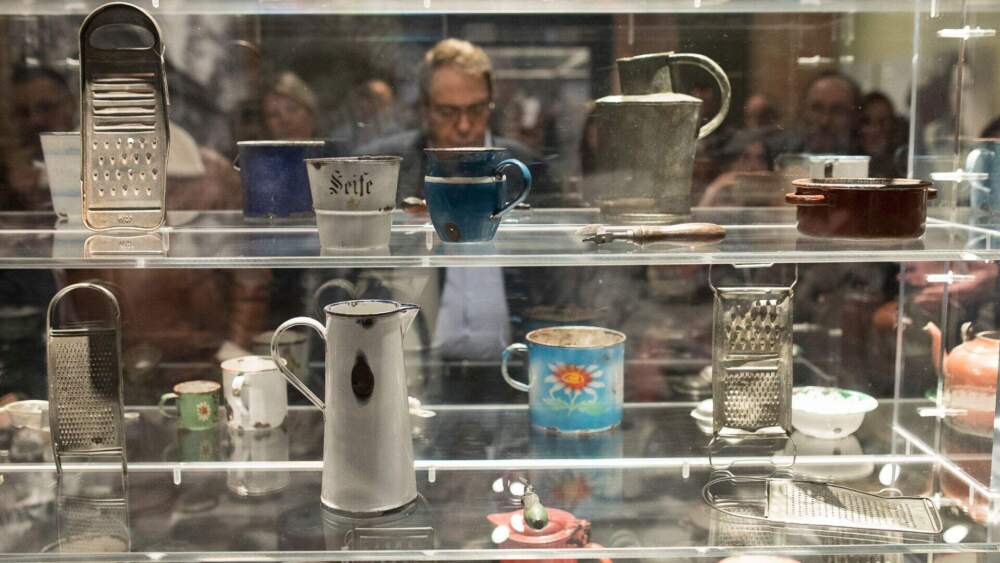
" Auschwitz. Not Long Ago. Not Far Away " is on view at the Castle at Park Plaza through Sept. 2.
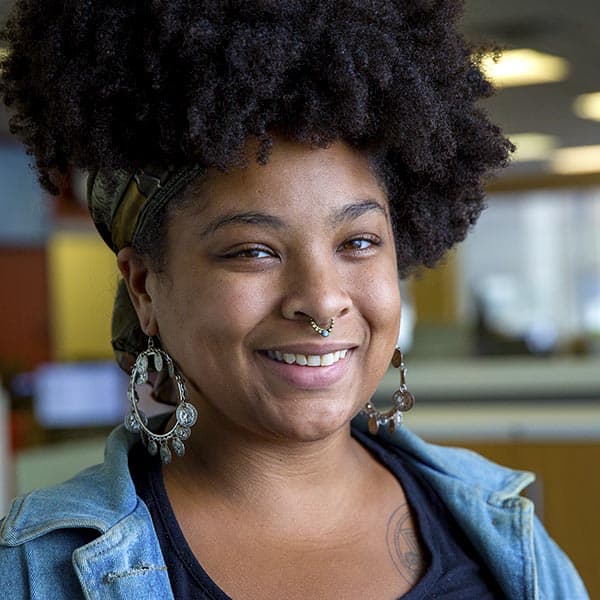
Arielle Gray Reporter Arielle Gray is a reporter for WBUR.
More from WBUR
- Sign Up / Log In
Create a free profile to get unlimited access to exclusive show news, updates, and more!
Everything To Know About The Peacock Limited Series The Tattooist of Auschwitz
The 6-part series, The Tattooist of Auschwitz , brings a heart-wrenching cinematic experience to the small screen.
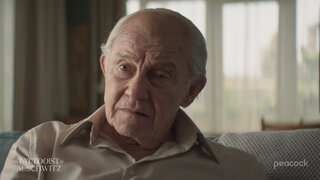
The trailer for The Tattooist of Auschwitz begins with the words, “We must keep living,” as a young couple embraces against a nightmarish backdrop: the Nazi’s largest and most notorious concentration camp during the Holocaust. The Peacock limited series brings to life the vivid memories of an elderly Holocaust survivor, Lali Sokolov, who was imprisoned at Auschwitz during WWII and forced to work as a tätowierer, who tattooed identification numbers onto fellow prisoners’ arms.
Lali meets and falls in love with a young woman named Gita as he’s inking her arm, and the two navigate the horrors of their internment in a desperate quest to survive.
Ahead of all episodes of The Tattooist of Aschwitz dropping on Peacock, below is a rundown of everything there is to know about the upcoming limited series.
Is The Tattooist of Auschwitz Based on a Book?
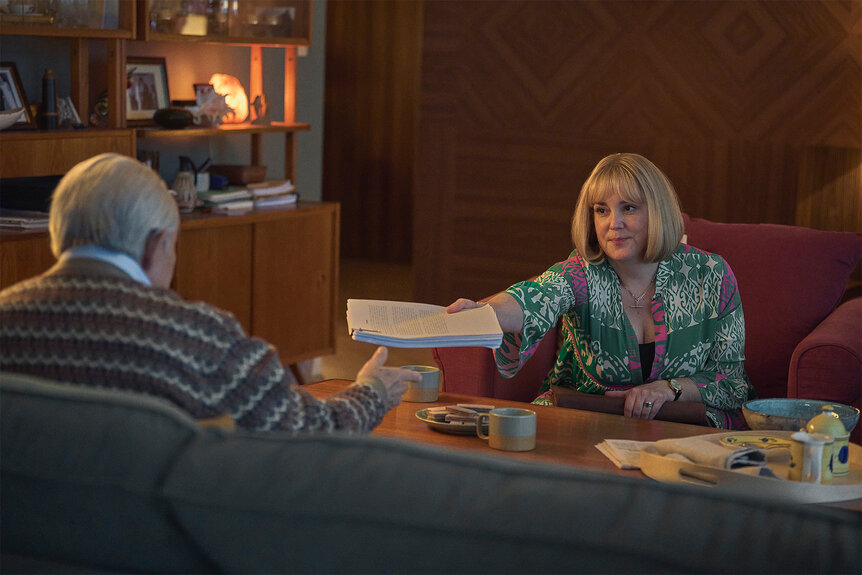
The series was inspired by the novel of the same name, a global best-seller written by Australian author Heather Morris. In her book, she recounts the stories of real-life Holocaust survivor and Auschwitz tattooist Ludwig Sokolov, whom she met in 2003, where he lived in Australia for 58 years after surviving the horros of Auschwitz and the Nazi Holocaust. The book is based on years of interviews Morris conducted with Sokolov, and she shares more of his heart-wrenching life story in her best-selling follow-up novel, “Cilka’s Journey.”
Who stars in The Tattooist of Auschwitz ?
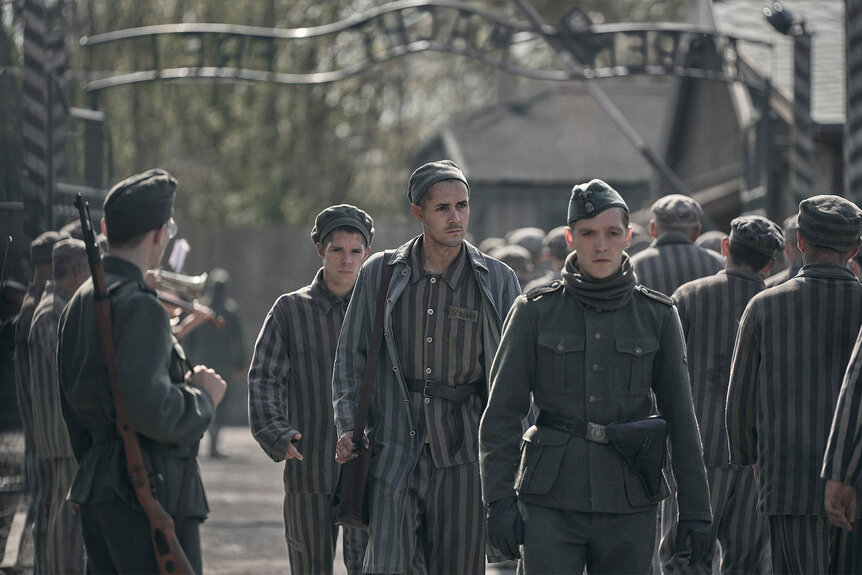
Legendary actor Harvey Keitel plays an elderly Lali, who recounts his ordeal years later with writer Morris, portrayed by Melanie Lynskey ( The Last of Us , Yellowjackets ). The plot of the series is told through his remembrances, interweaving the present day with hauntingly real scenes of the extermination camp at the peak of the war. The filmmakers rebuilt Auschwitz in painstaking detail on a set in Slovakia, Lali's birthplace.
Jonah Hauer-King tackles the part of young Lali. He’s best known for his role as the dashing Prince Eric in Disney’s live-action version of The Little Mermaid and for appearing in the 2019 Holocaust drama The Song of Names . Producer Claire Mundell of Synchronicity Films said it was “important” to have Jewish actors portray the roles of both young and old Lali.
Hauer-King plays opposite up-and-coming Polish actress Anna Próchniak (Gita), a former ballerina who starred in the Oscar-nominated WWII-era French film The Innocents. Jonas Nay of the German TV series Deutschland 83 (and sequels Deutschland 86 and 89) takes on a role inspired by the real-life SS Officer Stefan Baretzki.
The original score was composed by two-time Oscar winner Hans Zimmer ( Dune , The Lion King ) and Kara Talve ( Prehistoric Planet ).
Directed and co-executive-produced by Tali Shalom-Ezer ( The Psychologist ), with producers and writers Jacquelin Perske and Evan Placey, the series is a co-production between Sky Studios and Peacock.
Where and when can I watch The Tattooist of Auschwitz ?
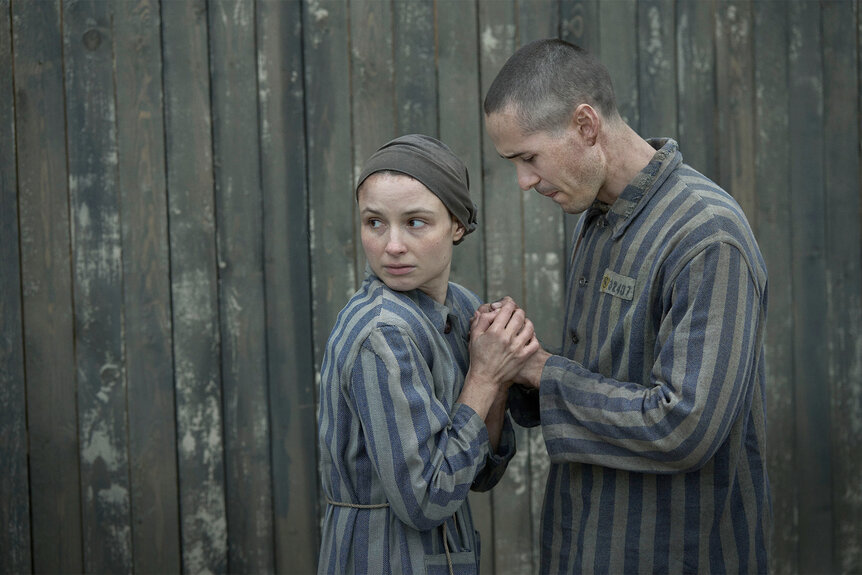
The entire original limited series will be available on Thursday, May 2, when all six episodes will be released simultaneously on Peacock in the U.S.
British Sky Atlantic will stream the series on NOW for those in the UK and Ireland, Italy, Germany, Austria, and Switzerland.
- The Tattooist Of Auschwitz
- Where To Watch
Related Stories

Is SNL Tonight New? March 23
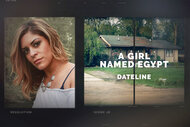
Detectives Reveal Clues in Murder of 27-Year-Old Singer
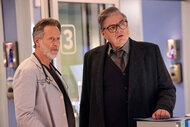
Chicago Med Has Been Renewed for Season 10 — All To Know

How to Watch Shakira on The Tonight Show Starring Jimmy Fallon
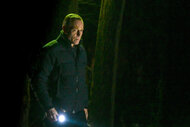
Is a New Episode of Chicago P.D. on Tonight, March 20?
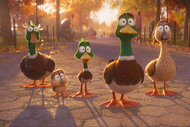
Migration Comes to Stream on Peacock

Jessica Biel to Lead The Good Daughter at Peacock
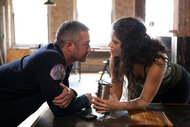
Is Chicago Fire New Tonight? (March 20, 2024)

Where to Watch Orlando Bloom: To the Edge Docuseries

Community Seasons 1-6 Will Be Streaming on Peacock

Where to Watch American Ninja Warrior on NBC

Where to Watch Weakest Link, Hosted by Jane Lynch
Recommended for you.

2-Year-Old Mariska Hargitay Appears on the Merv Griffin Show
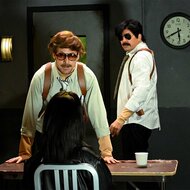
Ryan Gosling and Jimmy Fallon Deserve Oscars for Playing Identical-Looking Tough Cops

Scarlett Johansson Matches Katie Britt's SOTU Energy in SNL Parody: Watch
Virtual Tour
- Interior of gas chamber and crematorium I
In the neighborhood
- Oprowadzanie zdalne PE MCEAH
- Auschwitz-Birkenau - Alte Judenrampe
- Auschwitz II-Birkenau
- Panorama of Auschwitz I - a bird's eye view
- 'Arbeit Macht Frei' gate
- View from a watchtower
- March Of The Living 2013
- SS barracks
- Camp buildings
- Camp blocks
- Roll-call square
- Camp hospital
- so-called birch lane
- Group gallows
- Camp kitchen
- Block 10. Corridor
- Block 10. Toilets
- Block 10. Prisoners' room
- Block 10. Dissection room
- Block 10. Second floor
- Block 11. Court
- Execution wall
- Execution wall - ceremony of the anniversary of liberation
- Block 11. First floor corridor
- Block 11. SS office
- Block 11. Summary court room
- Block 7. Exhibition. Prisoners' bunks
- Block 11. Exhibition. Drawings of executions
- Block 11. Portable gallows
- Block 11. Cellars
- Block 11. Prison cell
- Block 11. Standing cells
- Block 11. Starvation cell
- Gallows where camp commandant was executed
- Crematorium I
JTA Sections
Get jta's daily briefing in your inbox.
I accept the JTA Privacy Policy .
By submitting the above I agree to the privacy policy and terms of use of JTA.org
The Museum of Jewish Heritage seeks to educate more college-age visitors about the Holocaust, starting with a private tour for CUNY students
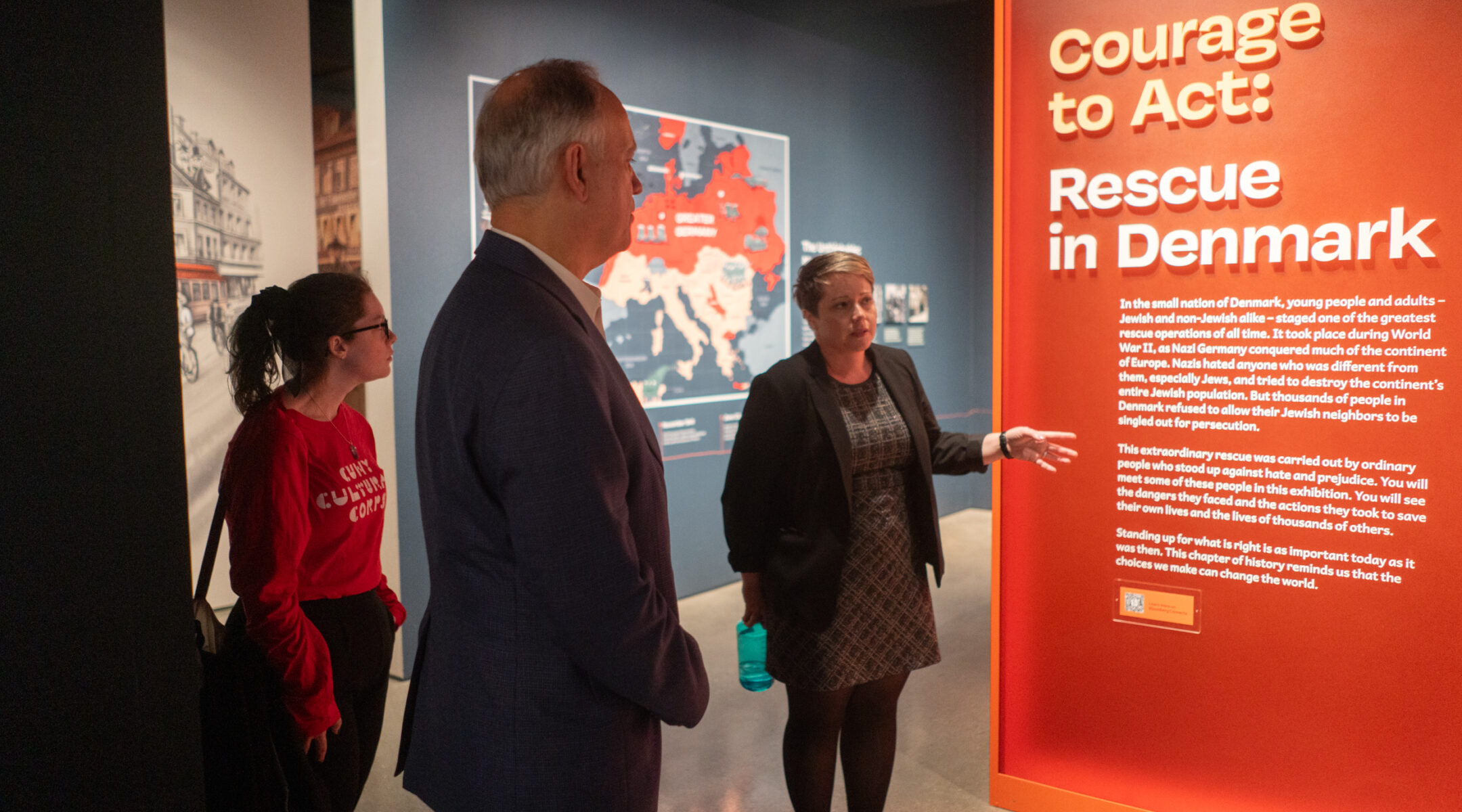
( New York Jewish Week ) – Last week, a group of students from the City University of New York, accompanied by CUNY Chancellor Félix Matos Rodríguez, listened in attentive silence to the story of Denmark’s Jews during the Holocaust and the citizen efforts to evacuate them to Sweden to escape the Nazis.
The private tour of the Museum of Jewish Heritage, part of a partnership with CUNY that started last year, is an early step in the museum’s push to expand its reach to a college-age audience as reports have piled up of antisemitism on campuses around the country. The effort comes several years after officials in New York City made the museum a central part of efforts to inoculate high school students against antisemitism.
“You’re giving them history, you’re giving them the right information, you give them context,” Rodríguez told the New York Jewish Week. “Those are all great, important skills that they need to combat antisemitism, to combat any form of hate, so for us this kind of program is really, really important, always, but I think particularly during these days.”
The museum plans to increase the number of campus visitors, train more college-age educators and expand its outreach to campuses, both physically and virtually. The goal is to educate young people about historical and contemporary antisemitism and combat misinformation.
Sign up for our newsletter to get must-read New York stories each day
By submitting, I agree to the JTA/New York Jewish Week privacy policy & terms of use .
The museum is in talks with three or four universities in the New York area that are interested in cooperating on Holocaust and antisemitism education, said the museum’s president and CEO, Jack Kliger, who declined to name the specific colleges because the agreements have not been finalized. The museum will hear feedback and conduct research over the summer, and plans to start rolling out the new programs on campuses in the fall.
“There’s just a tremendous amount of misinformation, disinformation and bad information out there, so we see our mission as providing good information to fight bad information,” Kliger said.
The initiative aims to combat antisemitism by addressing historical misconceptions, including by dispelling generalizations about Jews and other groups, and by opening up dialogue “in a positive, mutual and respectful atmosphere,” Kliger said.
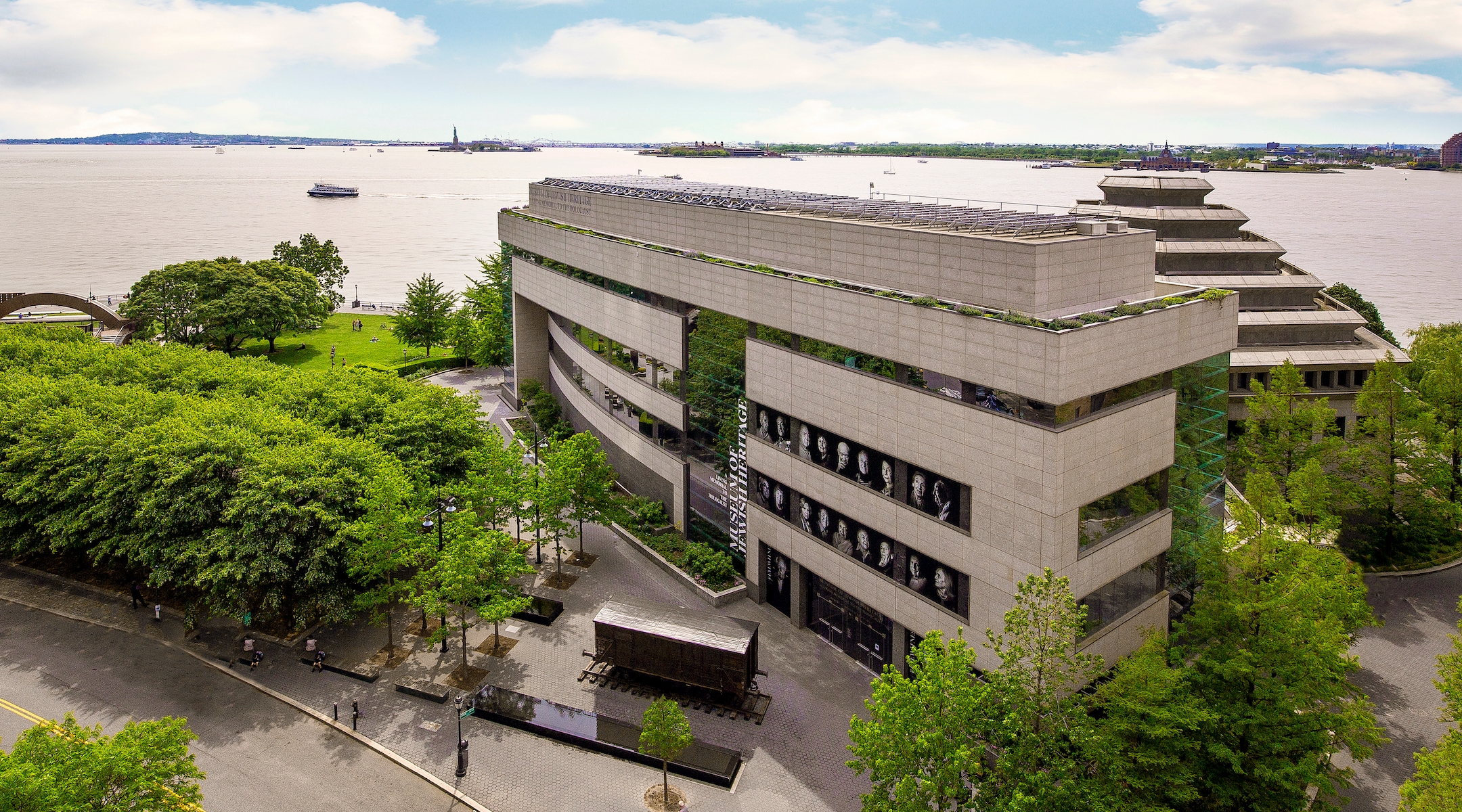
An image showing the Museum of Jewish Heritage-A Living Memorial to the Holocaust in New York City. (Museum of Jewish Heritage/John Halpern)
The CUNY program serves as a model for the expansion. Close to 100 students who volunteered for the visit toured the museum throughout the day on March 15. Rodríguez joined a group of around a dozen students for an exhibit called “ Courage to Act: Rescue in Denmark ,” focused on the Gerda III, a small fishing vessel that rescued around 300 Jews from the Nazis.
CUNY, the nation’s largest public urban university system with 226,000 students, has grappled with allegations of campus antisemitism for years that have only mounted following the outbreak of the Israel-Hamas war . Visits to the museum in Lower Manhattan are part of CUNY’s efforts to combat discrimination against Jews with education. Rodríguez first visited the museum with a group of students last spring.
The museum previously focused its youth education efforts mainly on high school students, with 50,000 to 60,000 high schoolers visiting in the past year. Part of that effort is the museum’s Holocaust Educator School Partnership , a program that trains college interns to teach about the Holocaust in New York high schools. The program started three semesters ago with three trainees and now has 10, most of whom are not Jewish.
By the summer, the museum plans to have trained 25 interns. Kliger estimated that each educator reaches 750 to 1,000 high school students per semester. After the CUNY tour, the students had a luncheon with staffers from the museum to learn about the opportunities.
In addition to the educators, the museum aims to have 25,000 college students visit by the end of 2025, and reach 100,000 students in total on 100 campuses nationally through visits, on-campus activities and virtual programs.
Support the New York Jewish Week
Our nonprofit newsroom depends on readers like you. Make a donation now to support independent Jewish journalism in New York.
The plans predated Oct. 7, but the Hamas attack and ensuing antisemitism had “accelerated” the need to reach people aged 18-24, Kliger said. The museum believes it is important to get young adults information about the Holocaust because they are at the stage in life when they are “forming themselves and they’re starting out in the world.” Both traditional and social media were spreading inaccurate information that the museum hopes to counter, he said.
The museum has not yet determined how it will approach Israel in its curricula, but “there’s no question we’ll talk about the subject of Zionism and anti-Zionism, where that bridges over into antisemitism,” Kliger said.
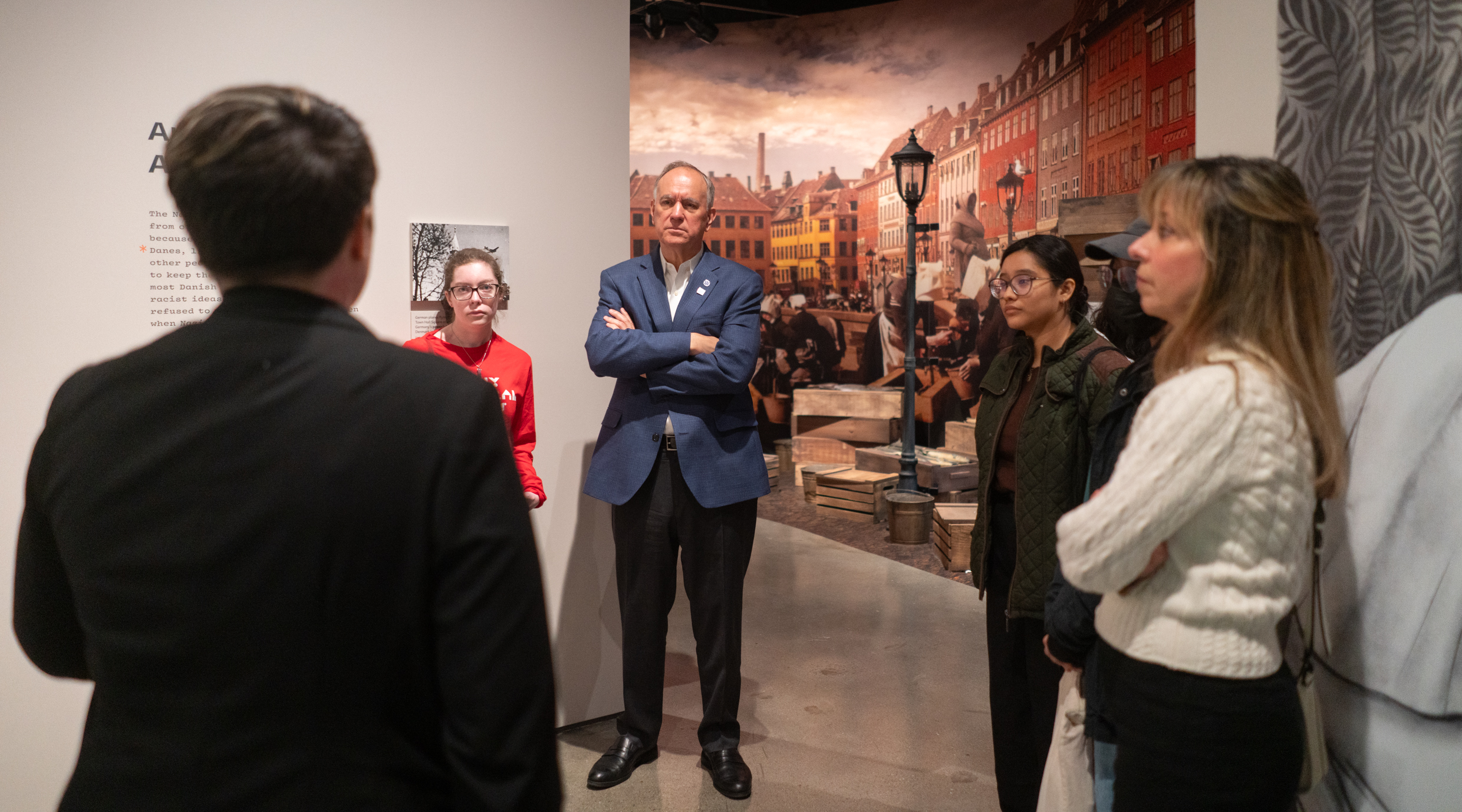
CUNY students and CUNY Chancellor Félix V. Matos Rodríguez tour the Museum of Jewish Heritage, March 15, 2024. (Luke Tress)
To that end, earlier this month, the museum released a resource guide for educators that answers common questions they might receive about antisemitism, part of an effort to focus more on contemporary antisemitism as the museum’s mission evolves.
“When we opened the museum in 1997 we thought antisemitism was on the wane and we were talking about lessons of history from the Holocaust, and clearly antisemitism is not on the wane,” Kliger said. Since Oct. 7, educators are getting more questions about “fluidity between what is considered antisemitism and anti-Zionism or what Zionism is,” Kliger said.
During the CUNY tour, Kliger and the chairman of the museum, Bruce Ratner, greeted an enthusiastic Rodríguez and a group of CUNY students as they arrived at the museum. Rodríguez wore a blue square on his lapel, part of a partnership between CUNY and Robert Kraft’s Foundation to Combat Antisemitism. The students all told Kliger it was their first time visiting the museum.
The Courage to Act exhibit focused on Danish civilians rescuing 95% of the country’s Jews during the Holocaust. In addition to expanding to young adults, the museum is looking to have younger students visit, and the exhibit was the museum’s first for visitors as young as 9 . The students and Rodríguez were quiet, attentive, and asked a few questions.
“There’s a ton of information, a lot of history that I didn’t even think is out there regarding the Holocaust. I only know what I know from school, the textbooks,” said Aishat Balogun, a senior studying economics at Hunter College. Balogun is in CUNY’s Cultural Corps program that connects students with job opportunities in the city’s arts and culture sectors and learned about the trip through an email.
Balogun, who is not Jewish, said the lessons were important in the current climate because “there has been a lot of hate.”
“It just seems like there’s so much going on, it’s really important to educate yourself and know how to have your own opinions and not just follow society,” she said.
Daniela Urbano, a third-year accounting major at Hunter, said there had been a gap in her education about the Holocaust. She learned about it in elementary school but didn’t recall any lessons in middle or high school. She and her sister had been interested in the subject and watched films on their own, which kept up her curiosity and motivated her to visit the museum. It was her first time visiting any Holocaust museum.
Urbano, who is also not Jewish, said she had been inspired by the Danish resistance.
“So many people stood silent and did not speak or advocate. You really saw how that helped oppress the Jewish people and a lot of other people, minority groups that were targeted by the Nazis,” she said.
“A lot of times, when it’s events like this, you really lose that personal connection when you learn it in a textbook. It feels different from seeing actual survivors talk about it and seeing children that were alive,” she said. “Many of them didn’t come out alive and I think it brings you a sense of how much of a travesty it really was.”
Kliger said he was inspired to work in education by his mother, a survivor from Budapest who had wanted to be a teacher but was blocked from the field due to discrimination. He acknowledged that Holocaust education was not going to eradicate antisemitism but believed the effort has an impact.
“Is there an ideal world where there’s going to be an elimination of antisemitism? I don’t think there will be, but the worst thing in the world would be to stop doing what we’re doing,” he said. “Is this sailing into the wind? Yeah. Should we pull down our sails? No.”
Share this:
More from new york.
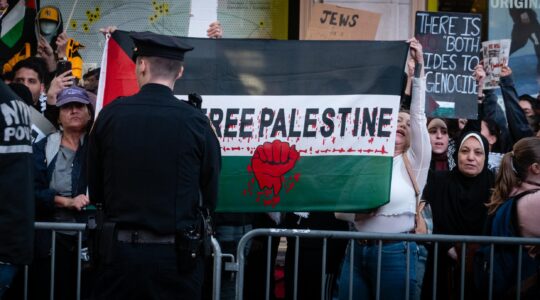
Queens College Hillel calls pro-Hitler graffiti a threat to student safety, demands action from administration
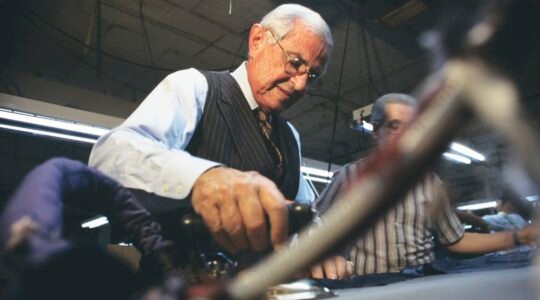
Martin Greenfield, Auschwitz survivor and master tailor to American presidents, dies at 95

Just in time for Purim, local businesses offer Jewish revelers pricey IV hangover ‘cures’
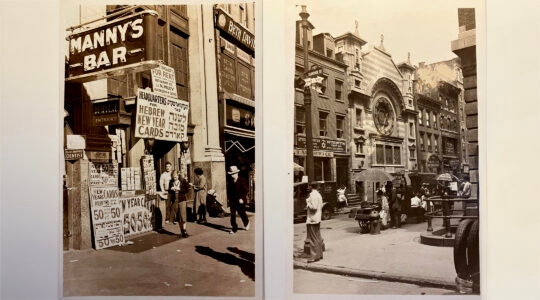
The New York Public Library’s Jewish division digitized 800 years of Jewish history
- Share full article
Advertisement
Supported by
Guest Essay
The Oscar Contender That Won’t Let Us Look Away

By David Klion
Mr. Klion is a journalist and cultural critic.
Any filmmaker trying to draw meaning from the Holocaust onscreen faces potential pitfalls. If you showcase individual human perseverance, as in Agnieszka Holland’s 1990 film “Europa Europa,” you risk trivialization; if you attempt to dramatize the inside of a concentration camp, as in Roberto Benigni’s 1997 film “Life Is Beautiful,” you risk exploitation; if you’re simply interested in preserving the testimony of survivors, you risk redundancy with what Claude Lanzmann accomplished in the 1985 film “Shoah.”
Steven Spielberg’s 1993 film “Schindler’s List” is a masterpiece that consciously navigates these risks, but it, too, has faced criticism for sentimentality and for centering the figure of a righteous gentile.
Jonathan Glazer’s “The Zone of Interest,” a dark horse candidate for best picture at the Academy Awards on Sunday, avoids all of these traps and finds something new and profoundly unsettling to say about the Holocaust. Mr. Spielberg recently called it “the best Holocaust movie I’ve witnessed since my own.” The film also accomplishes something more relevant to the present, forcing viewers to confront difficult questions about our own proximity to atrocity, and succeeding as a bracing reminder of how art can alert and sensitize us to the historical moment we inhabit.
“Zone” is ostensibly about the genocide of European Jewry, but its focus is not on the Jewish victims, who remain almost entirely offscreen. Rather, Mr. Glazer exposes the perpetrators to the scrutiny of the audience’s gaze. “Zone” depicts the life of Rudolf Höss, the commandant of Auschwitz, and his family at their handsome estate just outside the walls of the death camp.
We don’t see prisoners gunned down or stripped naked and marched to the gas chambers. What we do see — and thanks to a chilling and ingenious sound design, hear — are plumes of smoke rising above the incinerators, glimpsed through the window of a bedroom, and the distant rattle of gunfire on the other side of the wall as we tour the pristine garden that Rudolf’s wife, Hedwig, enjoys showing off to guests.
In one of the most disturbing scenes, we watch as a stream of dark ash overtakes the neighboring brook in which Rudolf and his children have gone for a dip. The father is horrified — not at the slaughter implied by this pollution, but at the possibility of his family’s contamination — and a frantic cleansing ensues.
While the film does not ask that we empathize with the Hösses, the conventions of storytelling dictate that we can’t help but identify with them. Some critics have called this approach hollow or even kitschy , an over-aestheticized art house stunt that tells us nothing new about Auschwitz. “The Zone of Interest” has made many of its more sympathetic critics uncomfortable, and that’s by design. “For me, this is not a film about the past,” Mr. Glazer told The Guardian. “It’s trying to be about now, and about us and our similarity to the perpetrators, not our similarity to the victims.”
By keeping the violence of the camp just barely out of frame, Mr. Glazer renders it an omnipresent backdrop to everyday life. In compelling us to spend time with the Hösses, the film demands that we reflect not only on the Holocaust but also on our own degrees of complicity in the horrors that we know are being carried out on the other sides of figurative and literal walls today.
Höss is the overseer of Auschwitz and enters the camp every day, but his wife and children don’t see what’s on the other side of the wall. Yet much of the film’s impact comes in dissecting how they are broadly aware of what goes on and are directly implicated, while still able to carry on their routine lives mostly unperturbed. Watching “The Zone of Interest” as U.S.-made bombs rained down on civilian neighborhoods in Gaza, I couldn’t help but dwell on the banal acceptance of these mass civilian casualties that I’ve witnessed closer to home.
I’m not alone in drawing that connection. One of the film’s producers, James Wilson, in his BAFTA acceptance speech last month, spoke of “the walls we construct in our lives which we choose not to look behind” and of “innocent people being killed in Gaza or Yemen.” While accepting a technical achievement award for the film’s mesmerizing soundtrack at the London Critics’ Circle Film Awards, Mica Levi took the opportunity to call for a cease-fire in Gaza.
Mx. Levi — who, like Mr. Glazer and Mr. Wilson, is Jewish — is one of the few entertainment industry figures this awards season to have taken a public stand on Israel’s military siege against the Palestinians. For Jews like myself, who publicly oppose Israel’s actions in Gaza, one of the hardest realities to confront is the fact that plenty of people in our communities are aware that the Israeli offensive is killing tens of thousands of Palestinians, many of whom are children. But in the wake of the gruesome Oct. 7 Hamas attack on Israelis that touched off the war, many people we are close to are not just incurious about Israel’s assault on Gaza but are willing to justify it without apology.
This is the thoroughly modern unease that “Zone of Interest” taps into. The advent of social media means that many of us are confronted with human suffering and injustice as an ambient fact of daily life, and not only in Israel and Gaza, but around the world. By necessity we can develop an instinct to minimize, dismiss or, in some cases, even defend human suffering — which is the very instinct that “Zone of Interest” intends to expose. It turns the audience’s gaze on the perpetrators, but it also implicitly asks us to examine our own roles.
The closest artistic precedent to the approach of “The Zone of Interest” is not a Holocaust film at all, but rather Joshua Oppenheimer’s 2012 documentary “The Act of Killing.” In examining the U.S.-backed Indonesian mass killings of the mid-1960s, Mr. Oppenheimer asks living perpetrators of the massacres to recount and dramatically re-enact their crimes. The perpetrators initially take up this task with a comic relish that comes across as profoundly inappropriate and discomfiting. “The Act of Killing” ends with one of its subjects retching over what he has spent decades being outwardly proud of. His discomfort doesn’t begin to address the scale of the damage he did, but it’s a visceral expression of regret.
The sequence is deliberately echoed in Mr. Glazer’s film. “Zone” ends with Höss dry-heaving after a night of partying with other Nazi officials as he momentarily seems to contemplate a future — our own present — in which all he did at Auschwitz is reduced to a sterile museum exhibit in a free Poland. No conscious part of Höss is in doubt about the correctness of his project, but on some basic level his body revolts against its own evil.
“The Zone of Interest” offers no moral redemption for the Hösses. Nor does it offer audiences the satisfaction of seeing Höss captured by the Allied powers and executed. There are no Jewish survivors to celebrate onscreen, nothing to distract us from the reality that the majority of Europe’s Jews were successfully exterminated.
Having closely observed a living instrument of genocide for the duration of the film, we are extended no solace and we exit the theater feeling a little unclean, as though we participated ourselves. Perhaps in another context we might have. Perhaps in another context we are.
David Klion is a journalist and cultural critic at work on a book about the legacy of neoconservatism.
The Times is committed to publishing a diversity of letters to the editor. We’d like to hear what you think about this or any of our articles. Here are some tips . And here’s our email: [email protected] .
Follow the New York Times Opinion section on Facebook , Instagram , TikTok , X and Threads .

Guided Tours for Individual Visitors
Individual visitors may tour the Memorial independently or in organised groups with a guide-educator.
Entrance to the Museum, to both Auschwitz I and Birkenau parts, is possible only with a personalized entry pass booked in advance. Reservations can be made at visit.auschwitz.org or on the spot at the cashier. The number of entry passes available is limited.
Due to the limited number of the entry passes visitors are kindly requested to book in advance at the website visit.auschwitz.org , as well as to arrive 30 minutes before the start of the tour. Larger luggage should be left in vehicles in the car park. Before the visit, please read the rules of visiting and the opening hours of the Museum.
VISITING WITHOUT A GUIDE-EDUCATOR
Tour without a guide-educator is possible at certain times subject to free Entry Passes, which may be downloaded from the tour booking system :
- January, November: form 1.00 PM
- February: from 2.00 PM
- March, October: from 3.00 PM
- April, May, September: from 4.00 PM
- June - August: from 4:00 PM
- December: from 12.00 PM
During the dates provided below, entrance to Museum is only possible with a guide-educator:
- January, November: from 7.30 AM to 1.00 PM
- February: from 7.30 AM to 2.00 PM
- March, October: from 7.30 AM to 3.00 PM
- April, May, September: from 7.30 AM to 4.00 PM
- June - August: from 7:30 AM to 4:00 PM
- December: from 7.30 AM to 12.00 PM
VISITING WITH A GUIDE-EDUCATOR
• Polish from 8.30, 9.00 to 13.00 in every hour • English from 8.30 to 12.30 in every hour • French 11.45 • German 10.15 • Italian 11.15 • Spanish 10.45 • Russian 9.45
• Polish from 8.15, 9.00 to 13.00 in every hour • English from 8.30 to 13.30 in every hour • French 11.15 • German 10.45 • Italian 11.45 • Spanish 12.15 • Russian 10.15
• Polish from 8.15, 9.00 to 14.00 in every hour • English from 8.30 to 14.30 in every hour • French 10.15, 13.45 • German 9.45, 14.15 • Italian 11.15, 13.15 • Spanish 10.45, 14.45 • Russian 11.45
APRIL / MAY / JUNE
• Polish from 8.15 to 15.15 in 30 min. • English from 8.30 to 15.30 in 30 min. • French 10.15, 12.45, 13.15 • German 9.45, 12.00, 14.45 • Italian 11.15, 12.45, 14.15 • Spanish 10.45, 12.15, 13.45 • Russian 9.15, 11.45, 15.15
JULY / AUGUST
• Polish 8.15, 8.45, 9.15, 9.45 and from 10.15 to 15.45 in every 15 min., 16.15, 16.45 • English 08.30, 9.00 and from 9.30 to 15.30 in every 15 min., 16.00, 16.30 • Czech 10.45, 14.15 • Slovak 9.45, 13:45 • Russian 9.15, 11.45, 15.15 • French 10.15, 12.45, 14:15 • German 9.45, 12.00, 14.45 • Spanish 10.45, 12.15, 14.45 • Italian 11.15, 12.45, 14.15
• Polish from 8.15 to 15.15 in every 30 min. • English from 8.30 to 15.30 in every 30 min. • Russian 9.15, 11.45, 15.15 • French 10:15, 12:45, 13:15 • German 9.45, 12.00, 14.45 • Spanish 10.45, 12.15, 13.45 • Italian 11.15, 12.45, 14.15
• Polish 8.15 and from 9.00 to 14.00 in every hour • English form 8.30 to 14.30 in every hour • Russian 11.45 • French 10.15, 13.45 • German 9.45, 14,15 • Spanish 10.45, 14.45 • Italian 11.15, 13.15
• Polish 8.15 and from 9.00 to 14.00 in every hour • English from 8.30 to 12.30 in every hour • French 11.45 • German 10.45 • Italian 11.15 • Spanish 12.15 • Russian 10.15
• Polish 8.15 and from 9.00 to 12.00 in every hour • English from 8.30 to 11.30 in every hour • French 11.45 • German 10.15 • Italian 11.15 • Spanish 10.45 • Russian 9.45
You can book a place on a tour at visit.auschwitz.org , where you will find information on available dates and prices of entry passes .
A tour lasts approximately 3.5 hours and it starts at Auschwitz I.
The price includes a tour of the former Auschwitz I and Auschwitz II-Birkenau camps with a guide-educator, rental of a headset. The Museum provides transfer between both sites of the former camp. The shuttle bus is intended for individual visitors in guided tours. The transfer takes place in accordance with security procedures in force in the territory of the Republic of Poland regarding public transport means.
Sale of entry passes for language tours ends 5 minutes before the start of the tour.
Concessionary entry passes are available to pupils and students aged up to 26 years, people over 75 years of age and disabled upon presentation of a proper document.
During periods of increased visitor traffic, there may be a temporary limitation in the availability of group tours.
STUDY TOURS
Study tours are organized everyday (tour takes around 6 hours):
• Polish 9.00
• German 9.15
• English 9.30
- via @auschwitzmuseum" aria-label="Udostępnij na Twitter">
Images from www.auschwitz.org may be used only in publications relating to the history of the German Nazi concentration and extermination camp Auschwitz-Birkenau or the activities of the Auschwitz Memorial. Their use must not tarnish the good reputation of the victims of KL Auschwitz. Any interference in the integrity of the images – including cropping or graphic processing – is prohibited. The use of the images for commercial purposes requires the Museum’s approval and information about the publication. Publishers undertake to indicate the authors and origin of the images: www.auschwitz.org, as well as to inform the Museum of the use of the images ([email protected]).

COMMENTS
More than 70 years have passed since the liberation of the Auschwitz-Birkenau concentration and extermination camp. More than a million people were murdered....
Auschwitz concentration camp was a network of concentration and extermination camps built and operated by the Third Reich in Polish areas annexed by Nazi Ger...
The Virtual Tour of Auschwitz explores the concentration camp complex of Auschwitz-Birkenau, the largest killing center in Nazi-occupied Europe. Located in Southern Poland, on the outskirts of the town of Oswiecim, it consisted of the original camp, Auschwitz I, and the much larger second camp of Birkenau (Brzezinka), 2 miles away, plus over 40 ...
Visiting the Auschwitz concentration camp in southern Poland, where more than one million people, mostly Jews, were killed by the Nazis during the Holocaust....
The Nazi German concentration camp and center for the extermination of Jews created during World War II on the outskirts of Oświęcim. Initially it consisted only of Auschwitz I, created in the spring of 1940, later also of the considerably larger Birkenau camp, and later still of Monowitz and almost 50 sub-camps of various sizes. Germans murder in Auschwitz at least 1,1 million people ...
Throughout the world, Auschwitz has become a symbol of terror, genocide, and the Holocaust. The German forces occupying Poland during the Second World War established a concentration camp, on the outskirts of the town of Oświęcim, in 1940; the Germans called the town Auschwitz and that is the name by which the camp was known. Over the next years it was expanded into three main camps ...
YouTube. The Museum's YouTube channel includes educational films, documentaries, programs held at the Museum, survivor testimony, and more. Browse selected Holocaust videos and playlists below. • Stay Connected: Lessons of the Holocaust • Survivors Remember Kristallnacht • Nazi Olympics: Berlin 1936 • Jewish Life Before World War II.
Entry cards are available at visit.auschwitz.org at "online individual visit" section. The online tour lasts about two hours and is divided into two parts - in Auschwitz I and Birkenau. The guide's narration is conducted live. Additionally, the educator will also use multimedia materials, archival photographs, artistic works, documents, and ...
Auschwitz I is where the Nazis opened the first Auschwitz camps for men and women, where they carried out the first experiments at using Zyklon B to put people to death, where they murdered the first mass transports of Jews, where they conducted the first criminal experiments on prisoners, where they carried out most of the executions by shooting, where the central jail for prisoners from all ...
Each includes tours of Auschwitz I and Auschwitz II-Birkenau. • General tours (2,5 h) • General tours (3,5 h) • Guided tours for individual visitors (3,5 h) • One-day study tours (6 h) • Two-day study tours (2x3 h) • Online tour (2 h) Because of a large number of visitors guides should be reserved at least two months before a ...
This is the original Virtual Tour of Auschwitz by Alan Jacobs. Each video gives you a 360 degree view of Auschwitz in video.
Marcin Łacina is a tour guide at Auschwitz, educating visitors from around the world about the evils perpetrated by the Nazis at the camp. Marcin Łacina has been leading tours of Auschwitz since ...
UNESCO/NHK Videos on Heritage ... show the conditions within which the Nazi genocide took place in the former concentration and extermination camp of Auschwitz-Birkenau, the largest in the Third Reich. According to historical investigations, 1.5 million people, among them a great number of Jews, were systematically starved, tortured and ...
Taking pictures and making videos is allowed in Auschwitz, for individual use, except in two places: the hall with the hair of Victims (block nr 4) and the basements of Block 11. ... In this part of the Auschwitz tour, you can take pictures everywhere except the two places in Blocks 4 and 11 - they will be clearly marked, and your educator ...
We offer visitors several options for guided tours. Each includes tours of Auschwitz I and Auschwitz II-Birkenau. • General tours (3,5 h) • Guided tours for individual visitors (3,5 h) • One or two-day study tours (6 h or 3+3 h) • General tours - shorter version before closing hours (2,5 h) • Online tour (2 h) Because of a large ...
*LEARN HOW I TRAVEL FULL-TIME*🌍 https://www.ashleysplanet.co.uk*WELCOME TO AUSCHWITZ*The Complete DISTURBING Tour, WARNING: Actual footage. Auschwitz concen...
Auschwitz, the largest and arguably the most notorious of all the Nazi death camps, opened in the spring of 1940. Its first commandant was Rudolf Höss (1900-47), who previously had helped run the ...
Nearly 80 years ago, World War II was finally coming to an end. In January of 1945, the largest Nazi concentration camp, Auschwitz, was liberated by the Soviet army — around 7,000 people were ...
The trailer for The Tattooist of Auschwitz begins with the words, "We must keep living," as a young couple embraces against a nightmarish backdrop: the Nazi's largest and most notorious ...
Auschwitz-Birkenau - Alte Judenrampe; Oprowadzanie zdalne PE MCEAH; Auschwitz II-Birkenau; Panoramas. Panorama of Auschwitz I - a bird's eye view; Panorama of Auschwitz I - a bird's eye view; Panorama of Auschwitz I - a bird's eye view 'Arbeit Macht Frei' gate 'Arbeit Macht Frei' gate; View from a watchtower 'Arbeit Macht Frei' gate; March Of ...
Drone video shows the Auschwitz-Birkenau concentration camp as it is today - 70 years after it was liberated by Soviet troops. The camp in Poland is now main...
• Due to overwhelming demand, please book in advance and arrive at the Memorial at least 30 minutes before the start of the tour due to security checks. The main car park and entrance to the Museum is located at 55 Więźniów Oświęcimia Street. • The grounds and buildings of the Auschwitz I and Auschwitz II-Birkenau camps are open to ...
The private tour of the Museum of Jewish Heritage, part of a partnership with CUNY that started last year, is an early step in the museum's push to expand its reach to a college-age audience as ...
What happened to the Jews in Ausschwitz and how does a survivor describes the life in the concentration camp? In 1944, Ausschwitz was a central concentration...
Some critics have called this approach hollow or even kitschy, an over-aestheticized art house stunt that tells us nothing new about Auschwitz. "The Zone of Interest" has made many of its more ...
A tour lasts approximately 3.5 hours and it starts at Auschwitz I. The price includes a tour of the former Auschwitz I and Auschwitz II-Birkenau camps with a guide-educator, rental of a headset. The Museum provides transfer between both sites of the former camp. The shuttle bus is intended for individual visitors in guided tours.